#African Grey weight
Explore tagged Tumblr posts
Text
How to Tell When African Grey Parrot Is Fully Grown?
Learn the signs of an African grey parrot maturity, including changes in feathers, eyes, size, and behavior, in this informative guide.
#african grey lifespan#africangrey#african grey parrot lifespan in captivity#cute birds#african grey behavior#tiktokparrot#african grey#african grey parrot#african grey parrot care#buying an african grey parrot#african grey characteristics#african grey eye color#African Grey feathering#african grey growth#African Grey growth phases#African Grey hatchling#african grey health issues#african grey life#African grey lifespan#African Grey maturity#African Grey nestling#African Grey parrot age#African Grey parrot growth#african grey parrot website#African Grey Parrots#african grey personality#African Grey size#african grey website#African Grey weight#balanced nutrition
0 notes
Text

African Forest Elephant (Loxodonta cyclotis)
Habitat & Distribution
Resides only in tropical rainforest
Native to West Africa and the Congo Basin, from Cameroon to the Democratic Republic of Congo
Physical Description
Weight: 4,000–7,000 kg (8,800–15,400 lb) for males, 2,000–4,000 kg (4,400–8,800 lb) for females
Height at shoulder: 2.4–3.0 m (7 ft 10 in – 9 ft 10 in) for males, 1.8–2.4 m (5 ft 11 in – 7 ft 10 in) for females
African forest elephants are grey all over; the skin is thick and wrinkled, especially around the joints
Both males and females have long, straight tusks which usually carry a pink tinge
Behaviour
Females travel in groups of up to 20, dominated by a matriarch, while bulls generally travel alone
Groups and lone bulls meet periodically at muddy watering holes, where they wallow, consume the mineral-rich sediment, and socialize
African forest elephants eat mainly leaves and tree bark, supplemented with fruits
They have few predators aside from humans
Key Advantages
The African forest elephant's sheer size allows it to trample smaller creatures
Adults can use their trunks and long tusks to defend themselves from predators
Photo by Jerome Delay
61 notes
·
View notes
Note
personally I'd love to see Kei with like the sneeziest, messiest cold ever. Does he try to keep it contained with tissues or thick handkerchiefs, he'd probably need some considering how stuffy his trunk must get when he has a cold
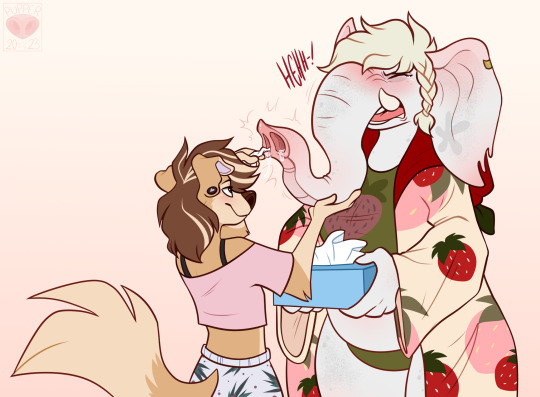
Art done by PupperStar on Furaffinity
Heeeere we go!! Keirie wakes up with a nasty head cold, and it’s made their nose hypersensitive to everything. Normal tasks become more difficult than ever, and they might end up calling for the assistance of their partner…
Loooads of nose/trunk related nonsense with this one, and a lot of desperation and mess too!
Doubling Down.
Kei tugged on their large, African elephant ears at the shrill cry of their phone alarm. It was piercing, louder than usual, and the weight of sleep was growing more and more inviting with every ring. Their trunk snaked out from under the duvets, and began to brush along the nightstand in search of their phone. Its tip shuffled around at the phone’s home button, but as they went to pinch down on it, the phone tumbled off and under the bed.
The sleek, polished surface of the nightstand went foggy from an annoyed sigh: “…damn it.”
Damn it, because now they had to do more blind searching. Keirie’s brows furrowed as their trunk urged away a few blankets, and rubbed along the floor. Hmm, to the left? Those were shoes…that was the safe box, and that had to be a t-shirt they were feeling…what was that??
It felt like a mix between rubber and velvet. Their trunk grasped at it, identifying a handle—oh! That was one of Kei’s dumbbells. They forgot they even had those, going to the gym more often meant less use for them at home…just the thought of having to work out today made them slump their shoulders with a huff.
“h-HHh!!”
Oh gods, that’s a lot of dust. Their nostrils flared, feeling all of the disrupted dust under the bed billowing around their damp septum. The dust would settle again, only most of it had already gotten sucked up into their trunk. It was like breathing in a bag full of craft feathers..!!
“H-hhUEH—!!” In any other circumstance, Kei would be a natural at keeping their sneezes under control. However, this feeling rushed over their eyes and nose faster than they could comprehend. “Hhh-hhHEESHHhhhHHW!!”
The first of many, doubtlessly. Dust exploded in thick clouds from the dormant, untouched nooks and crannies under the bed. Their nostrils gaped and trembled, while a second chorus of hitches drew in more dust towards it. Keirie, laying on their stomach above the bed, opened their eyes tearfully. “SnK-! SnrkK- snF! HHahh-! Add’DTTSSSchhuuw!!”
The phone still rang and demanded the elephant do something about it. It stung their head, they could feel it hammering at a festering headache. They finally fumbled their septum against the screen, and with a snort, the phone was grasped by the edges. With all the mess slowly trickling from both nares, the phone slipped and glided a few times. Eventually, however, a strong snort sucked the surface of the screen to their left nostril. It was masterfully lifted to their bleary eyes to check the time.
9 am. Well, 9:03 now. Their alarm was set this early to remind them of Colorguard Practice this noon. Auditions were coming up, given it was the start of the season, but something deep down was warning them not to attend today.
Once they sat up, it hit them. All of the weight in their throat dropped to the pit of their chest. All of the fatigue in their shoulders pulled their posture down like bags of sand on their back. Their nostrils, once dripping like a loose tap, began to drool in a massive amount of runny mess. The dust they inhaled was being flushed out too, visible in speckles of brown and grey.
Unmistakably, a head cold. A thermometer check in the bathroom confirmed it. Kei looked sadly to themselves in the mirror, and ripped a few tissues from a box on the shelf above them. Holding the tissues up against their trembling nostrils, they blew shakily, wincing at the thick sounds of congestion rushing forth. Dust and gunk, all built up from the morning—their nose stung intensely with the feeling, and they were soon hitching before they realized it.
“hH-! hEH! hHAHh!!” They staggered back clumsily, and aimed their trunk away from the sink bowl and towards the shelf. Their breath wavered dangerously, teetering a few bottles and boxes with the unrestrained energy of their hitches. “N-nDoe!! HUH-UPPSSshhww!!!”
Crash! Clatter! A cacophony of sound flooded the master bathroom as toothbrushes and medicine bottles and rolls of toilet paper went scattering. The mirror was splattered with water and mess, which sadly ran down the surface of the wall. Just as a knuckle rubbed cautiously under their trunk, one of the toothbrushes on an upper shelf rolled and fell, landing in one of their two upturned nostrils—brush side down.
“iHH-!!” Their left nostril trembled and the toothbrush rattled against their inner nose. Their nostrils flexed and it sank, completely disappearing from view. “H-hhhiih! EHH-! HEEISHhuhhw!!”
A sharp, open sneeze scraped their throat, and the toothbrush ricocheted off the sink bowl and smacked them between the eyes. “-dOwh!! Gah!”
Ugh, just thinking about going to practice like this made their stomach turn. Spinning flags through hitches, or sneezing mid-toss! They would send a text later this morning for certain, but the least they could do was start their day a little better than this…chaos.
A little breakfast could help to lift the spirits—it was the most important meal of the day! Only the fridge looked a little on the bare side; a bowl of veggies here, assorted carrots and celery that had yet to be cut, a head of lettuce, some onion…Hey! It wasn’t like they were going to fix up anything too fancy, so a salad would do them nicely. Slowly, they stumbled into the kitchen, hugging close to a strawberry-patterned bathrobe.
“I thing’k I need the greens,” Kei reasoned aloud as their trunk clutched a cluster of celery. Their hands reached In after collecting the various root and leaf vegetables. Once thoroughly washed under a tap, the ingredients were set aside, and Kei took a moment to bring their trunk under the warm water. The nostrils had grown a distracting shade of pink, flaring as water flooded them. Their small eyes watered, and both hands reached up to grab the base of their trunk—it truly took everything in their power not to snort or sniff!
“Stupid ru’ddy n’dose…” grumbled Kei stuffily, who turned off the tap and pointed their nostrils downward. Water came gently trickling out both of their slowly-widening nostrils. The rush was beginning to tickle, and the water didn’t show signs of stopping any time soon!
“Ih-!! It just won’t st-stop runninghHH!!” Keirie gasped, curling the base of their trunk upwards, “hRGGSHHhhhuuhw!!”
Water sprayed into the kitchen sink, splashing up and back to drench their shirt. Despite the exhausted sigh, their eyes revealed a smile—it was practically comedic at this point, wasn’t it? They shook their head and snuffled. “Mngh- snffk-! So sensitive today…headcolds, man…”
Oh, how Amalie would be racing to poke fun at them!
The thought alone seemed to quickly lift their spirits—wasn’t Amalie off work today? After alerting their group to the fact they wouldn’t be there, a quick text would confirm it; and was swiftly followed up with a request to come over. Of course, Amalie joyously obliged.
The salad was finished and eaten just as Amalie opened the door with her own key. In her hands were two compostable plastic bags, filled with goodies and care items. Her tail wagged quickly at the sight of Kei, and the wagging’s intensity seemed to increase after the sound of a waterlogged sneeze. Ah, how golden retrievers were as subtle as a freight train.
“Keirie! You should’ve told me you were sick, I had to run and get all of this on my way here!” She gasped, rushing over to set down the bags on the island, before leaping up to hug her partner.
“I did as soon as I could, I just w-woke ub’p like…a’d hour or two ago…”
“Poor thing, look at your nose…”
Kei’s beady eyes trailed down as Amalie held their trunk in cupped hands. The nostrils were slick and twitching, and Amalie extracted a box of tissues from the bag to begin patting away at the wetness.
“Gosh, gift-giving is your love language…” Kei chuffed out with amusement, looking through the bag themselves. They gasped as they made contact with a bag of de-shelled peanuts and pistachios, too! Among the two bags there were tissues, cold medicine, chills medicine, a restock on pain medication, a stuffed microwavable teddy bear, soup ingredients galore, just to name a few.
“H-hHUH-! Hey!!”
Kei felt their nostrils begin to tremble as they looked back at their girlfriend. She was busy stuffing a tissue into their left nare.
“SuhH-! Stop you’re gunnAH- AHHh—!! hAPPSCHHhuuhw!!” They paused with a chesty sneeze, “…gonna make me sneeze…”
“Oh, my apologies,” Amalie spoke knowingly, pulling out the tissue to reveal that the end was coiled tightly to a definite point. Kei squinted critically, matching the coy smile.
“You’re cheeky—don’t get yourself sick from this, you hear?”
“Promise I won’t…has this big old thing been bothering you?” She gestured lengthwise to their trunk.
“Trust me, I’ve been sneezing since I opened my eyes…”
“Oh what a shame…” sighed Amalie sarcastically. “Who knows? Maybe it’s just a sign to get some out…?”
“Sure, cure my sneezing with more sneezes, sounds logical to me!” Kei rolled their eyes. They took the tissue box from Amalie in their hands, at least to hold it idley amongst their girlfriend’s antics. The twisted tissue rummaged invasively at their flaring nostrils, and they felt tears overwhelming their eyes in moments. They felt so incredibly full with mess, it had been giving them a headache. It wasn’t necessarily a stuffy nose, but rather a constantly runny one. Such a runny nose was utterly shameless in revealing itself before Amalie.
“hhuh…hHEH!”
Amalie’s tail lowered to wag, and she held the tip of their trunk steady in a firm grip. There was something that was so instinctively enticing about watching Kei’s nostrils flex and flare so wide. However, they let out a huff and a violent snort, and to Amalie’s surprise, the tissue slipped from her fingertips. She fruitlessly attempted to reach after it, but Keirie’s hitches were wildly blossoming out of control.
“EHH-! HEHH—!! hH-hAAAtshHHUUUHh!!” Amalie angled their trunk over her shoulder as she ducked. A few plastic dishes went clattering off of the kitchen island, too. Despite this, Amalie could tell with a glance that her partner wasn’t done. For one, the tissue was still stuck in their trunk, barely poking out of their wide and gaping nostrils. Amalie had the sense to let go of their nose, and tentatively duck behind the island themselves!
“HbBTSHhhuh- hAAHtshhHkk!! Heh-HHSHhhuuh!!”
“Bless you—! Bless! Bless you again…!”
“hehH!” Was all they could manage, “hhihs it still in’d my n-Nuh-!!?”
The elephant pointed to their trunk, where the soggy tissue still clung to their inner septum. Amalie nodded, but upon realizing they couldn’t see her, she approached. “Here, hold still!”
Keirie stiffened to the best of their ability. The tissue was extracted with ease too, and their next string of hitches died down into watery sniffles.
“Bless you, Keirie,” she chuckled, rubbing her partner’s drippy trunk with a palm. “Feel any better…?”
“Ehh,” spoken before a violent blow of their nose into a fresh tissue, “kinda, it definitely cleared my trunk, but I’ve got a headache…thanks for the meds too, I was running low…”
“No worries…let’s get you back in bed, then. It should be easier with someone looking out for you!!”
It was barely noon, and yet Kei found themselves getting tucked right back into bed! They unceremoniously flopped onto their back as they laid down, looking at the ceiling with half-lidded eyes. Their large ears shielded the beams of light from the nearby window, waiting quietly for Amalie to eventually come around and shut them. Once done, she shuffled right beside her partner, curling up with the small warm teddy bear between them.
“Th…thanks for coming over,” Kei yawned slowly.
“Mhm..!” The golden retriever’s tail began to wag gently, “let me know if you need anything, mkay…?”
“Mkay…”
Perhaps it was the mere prospect of Amalie’s presence that helped Kei doze off, but they soon found themselves drifting to sleep with relative ease. They were doubling down on this cold, and that much was for certain!
#kei the elephant#furquo#snzblr#furry snz#furquo mess#furquo fic#snz art#kei is non binary by the way! they use they/them
113 notes
·
View notes
Text
Writing Analysis: Of Mice and Men (Cultural References)
Bindle: A bag, sack, or carrying device.
Bindle Stiff: Hobo; transient who carries his belongings in a sack.
Bunk House: A sleeping quarters intended for use by multiple people.
Talcum Powder: Very similar in texture to baby powder, talcum powder was used mainly after bathing or shaving.
Apple Box: A box used for storage or as a stepstool capable of holding a person's weight.
Scourges: A widespread affliction, an epidemic illness or the consequence of some natural disaster, like fire, flood, or a migration of locusts.
Pants Rabbits: A sexually transmitted disease, known as pubic lice.
Graybacks: The equivalent of ticks or lice.
Liniment: A topical cream for the skin that helps with pain or rashes.
Jerkline Skinner: Lead driver of a team of mules
Stable Buck: A derogatory name for an African-American man who works in the stables.
Stetson Hat: A famous brand of hats, especially cowboy hats.
Swamper: A general assistant; handyman.
Murray and Ready: An employment agency, specializing in farm work.
Work Slips: Proof that people had been hired to do a job.
Cultivator: A farming tool used to stir and soften the soil either before or after planting.
Cesspool: A well or pit filled with drainage or sewage.
Slough: A muddy or marshy area.
Tart: A woman who tempts men or who is sexually promiscuous.
Buck Barley: To throw large bags of barley on a truck.
Lynch: To illegally execute a person, generally applied to the hanging and/or burning of African-Americans in the south.
Slug of Whiskey: Equivalent to a hip flask of whiskey.
Gut Ache: A stomach ache.
Airedale: A type of dog, specifically Terrier.
Pulp Magazine: During the 1920s-1950s, inexpensive fiction magazines. From 1950 on, the term also came to represent mass market paperbacks.
Luger: The Luger pistol was an expensive, high maintenance weapon manufactured and used primarily in the German army.
Euchre: A card game played in England, Canada, and some parts of the U.S.
Two Bits: Twenty-Five cents.
Rag Rug: Rugs created from rags that were tied together by knots.
Kewpie Doll: A particular style of doll, one that was usually won at carnivals.
Phonograph: The first device for recording and playing sound, most specifically music.
Parlor House: Could be considered a restaurant, but more often parlor houses were brothels.
Hutches: A form of furniture, very similar to a wardrobe.
Welter: A boxer (refers to welterweight, a weight class in boxing).
Nail keg: A wooden barrel that could usually hold 100 pounds or more inside.
Russian Hill: Affluent residential neighborhood in San Francisco, California.
Travels with a Donkey: Travels with a Donkey in the Cevennes (1879), one of Robert Louis Stevenson's earliest published works.
Varro: Marcus Terentius Varro (116-29 B.C.E.), Roman scholar/author and horticulturist.
Velasquez's Cardinal: Seventeenth-century painting by Spanish painter Diego Rodriguez de Silva y Velazquez.
Zane Grey: American adventure novelist (1872-1939).
Source ⚜ Writing Notes & References
#of mice and men#literature#writing analysis#cultural references#writing reference#writeblr#spilled ink#dark academia#writers on tumblr#writing prompt#poetry#poets on tumblr#light academia#studyblr#writing inspiration#writing ideas#writing inspo#writing resources
31 notes
·
View notes
Text
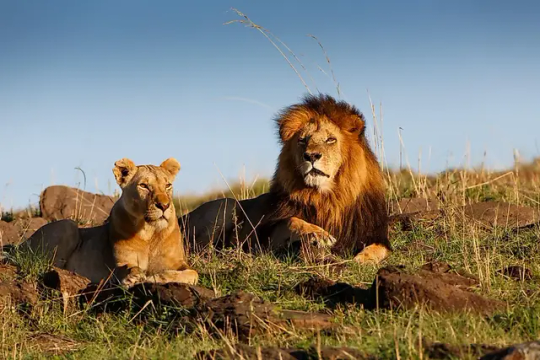



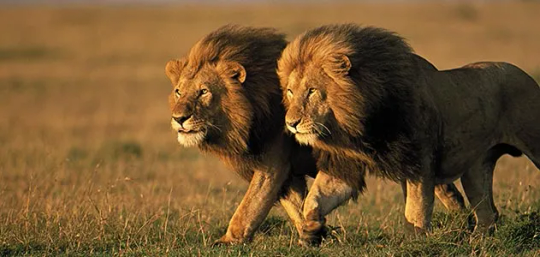

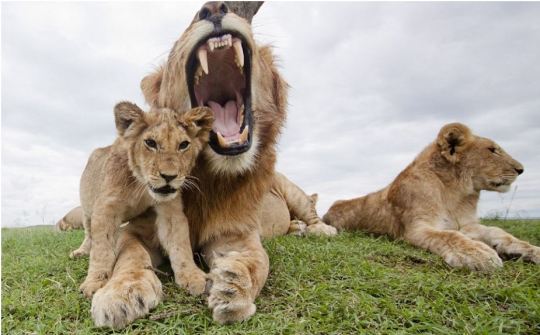

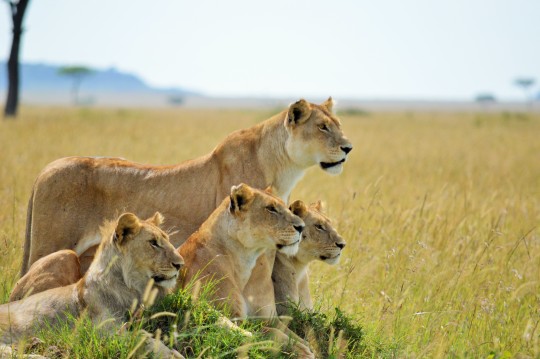
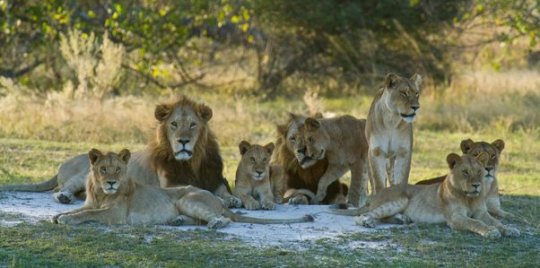
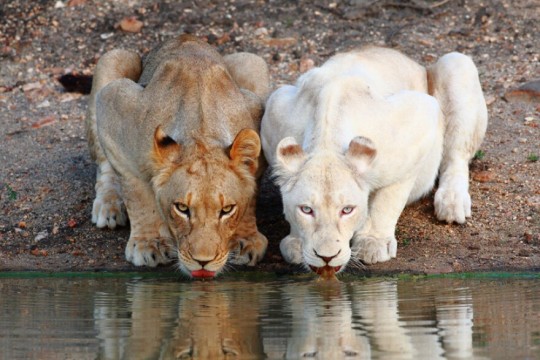
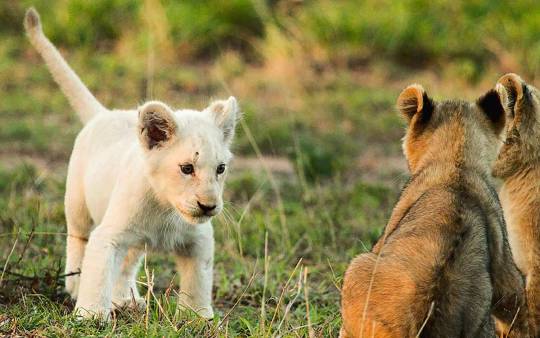
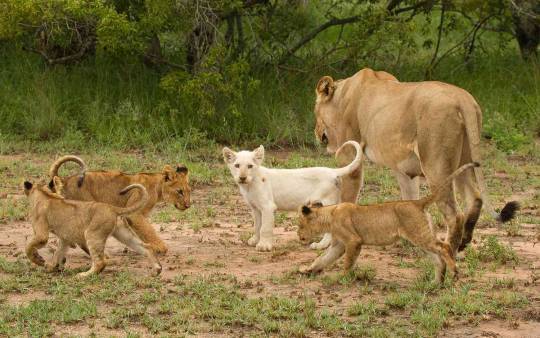
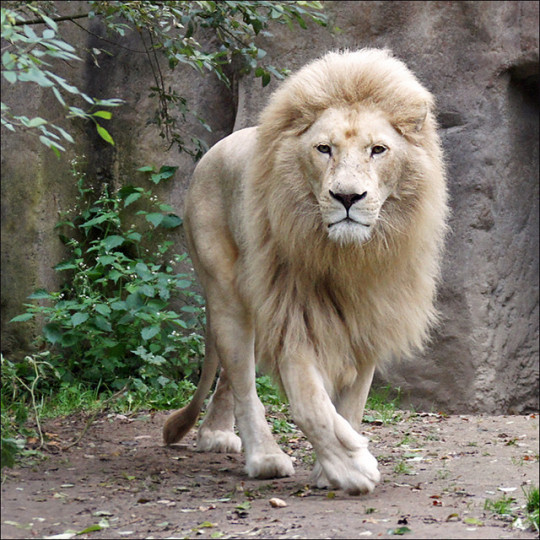
Panthera leo melanochaita better known as the east African lion, the Southern lion, the Southern African lion, or the East-Southern African lion,, is a subspecies of lion native to eastern and southern Africa. Here they prefer to inhabit grasslands and savannas, but are also known to inhabit open woodland, scrublands, and montane forests. African lions are the most social of all wild felines, living in groups of related individuals and their offspring called prides which number 3 to 30 females and 1 to 4 males. East African lions typically prey upon ungulates such as wildebeest, cape buffalo, eland, gemsbok, nyala, roan and sable antelope, warthogs, bush pigs, zebra, tsessebe, waterbuck, kudu, hartebeest, kob, and thomson’s gazelle, however they are also known to hunt other prey from as small as common mice to as large as young or infirm African bush elephants. Lions are themselves occasionally killed by other predators such as wild dogs, hyenas, leopards, other lions, and crocodiles. Female east African lions average around 7.5 to 8.9ft (2.3 to 2.7m) in length, and 183 to 370lbs (83 to 168kgs) in weight while males average around 8.1 to 9.4ft (2.47 to 2.84m) in length and 321 to 496lbs (145 to 225kgs) in weight, however lions as big as 11ft (3.35m) and 825lbs (375kgs) have been known to exist. This marks the lion as the second largest extant cat after the tiger. The lion is a muscular, broad-chested cat with a short, rounded head, a reduced neck, and round ears. The fur varies in color from light buff to silvery grey, yellowish red, and dark brown, additionally albino and leucistic individuals are not unheard of. Mature males typically sport long flowing manes, but may occasionally lack them. Additionally females may occasionally grown manes as well. Breeding may occur year round, with each mature female having there own estrous cycle. When in heat she will breed with one or more partners. After a 110 day pregnancy a mother lion will give birth to 1 to 4 cubs in a secluded den away from the rest of the pride. She will not rejoin the pride until her young are around 6 to 8 weeks of age. East African Lions reach maturity around 2 to 4 years of age, at which point the males are typically forcibly evicted from the pride and females may choose to set of in search of another to join. Under ideal conditions an east African lion may live up to 18 years.
#pleistocene pride#pleistocene#pliestocene pride#pliestocene#cenozoic#ice age#stone age#mammal#lion#africa#african lion#east african lion#white lion#cub#lioness#cat#big cats#feline
36 notes
·
View notes
Text
I just remembered that as much of a good guy Scrooge McDuck is now at some point in the Carl Barks and Don Rosa comics he did become a villain and a committed a hate crime against an African village which rightfully earned him a life curse with a zombie following him. Which is very bad and sad from him and it was absolutely horrible and he could never be excused for this, but the comics were aware of it and not forgiving him nor presenting him as the victim at all on the contrary, and it was good to see a main Disney character be morally grey and a kids media aknowledging you nearly can't become a billionaire without straying away from the light, having known an awful low which, even if he did become better again years later and was a good person before and he does have good in him, would never erase the atrocity he did commit that day and the curse remains well deserved. And himself knows, for he long accepted his fate and doesn't try to reverse it much as if it werd his own penitence, a literal materialized weight of guilt
And then DT17 just couldn't have morally grey characters for main characters especially in an era Disney became a huge monopoly billionaire company itself like Scrooge so they just erased his flaws and made him a good rich guy who just loves to adventure and aventures only always doing right financial choices an honest way because this is a good example for children and the zombie has nothing to do with him hiring mercenaries to burn down an African village in order to earn his 2nd billion so that new spoonfed fans who cry about complexity and call for cancelling anything wouldn't feel bad for liking him. It sucks
#also the HUGE stepback making his parents still alive because Disney is cowardly now and couldn't have him deal with grief. wow#them bastards !#scrooge mcduck#disney#ducktales#Cark Barks#Don Rosa#comics#DISNEY I'M MAD AT YOU
78 notes
·
View notes
Text
The Mean Girls musical remake has a general political problem caused by them overtly trying to be more progressive than both the first film and the play, meaning that whatever they do in the movie is specifically a statement and can't be excused by the nastiness of the setting and characters. They went to great effort to excise the meanness of the girls and any jokes that could be read as off-color (even at the expense of lyrics rhyming), while inserting cultural diversity and general political progressivism, so the film's political content is a didactic assertion of what is to be taken as good and correct. And that content is fatphobic, transphobic, and antisemitic.
The original film's concept was that Cady tries to infiltrate the Plastics (the mean girls) to destroy them from within but actually assimilates and becomes a mean girl, ending up Regina's match because she can out-mean her, and then must relearn how to be nice. As part of her takedown of Regina's reign, Cady attacks Regina's ability to influence people as a traditionally attractive older teen girl by tricking her into eating weight-gain supplements to make her fat. This is fundamentally antagonistic to fat girls but falls into a grey area where the whole setting is nasty, and most of the characters are cutthroat. It's literally in the name: Mean Girls. However, the second film goes to such efforts to sanitize everything and keep Cady likable while pushing political progressivism that the retention of the idea that Regina loses her attractiveness and becomes a figure of ridicule when she gains weight makes the film aggressively fatphobic. The film actually changes a detail to be more progressive, associated with racial politics, where Cady's parents originally had the weight-gain supplements to give to starving Africans, and then the new film has it that they had it to give to sick elderly people. They were concerned that the plot might be problematic enough to change that detail but retained laughing at Regina being fat and indicating she can no longer be seen as hot.
Similarly, the film's emphasis on gay-positivity in contrast to the original film, which was criticized for only implying Janis might be a lesbian, makes the transphobic jokes stand out as especially pointed. In the first film, Regina slanders Janis by spreading a rumor she's a lesbian, when it's left ambiguous if she is or isn't. In the second film, Janis comes out as a proud lesbian before Regina slanders her for being a stalker. That progressive portrayal of Janis' sexuality and reduction of Regina's homophobia combines with the positive portrayal of Damian as an out and proud gay guy, who has a very flamboyant personality in the new film, and the musical film's Broadway atmosphere to make a general assertion of strong gay positivity. This is the context in which two new jokes lead us to laugh at teen boys who transgress gender norms: Damian trying to use female names in French class before being put in his place by a female teacher, and sexual harrasser Jason being revealed as not as manly as he pretends when Regina pressures him to use a natural feminine voice.
In the first case, there's a weird idea put forward that being gay is good and being trans is bad. Damian is very well accepted in his environment as a gay guy, but his assertion of a female identity, a sort of drag persona, is framed as an obnoxious disruption that the teacher absolutely must put her foot down to stop. It's kind of a terf point, like the producers studied what was popular in the left and determined LGB Alliance was popular, so they could treat trans people as problematic while building up gay people to appeal to the left. Notably, the scene represents a change from the original aggressive white woman German teacher whose nature alluded to Nazism. The remake makes her a legitimately annoyed Asian woman French teacher who frames Damian's gayness positively while putting her foot down when he crosses the line and disrupts the gender binary.
In the second case, Jason is built up as unlikable so that his humiliation is cathartic, putting a sexist in his place. Regina is able to use her meanness for good. It is framed as a progressive, feminist change. It is also fundamentally transphobic for centering Jason's feminine natural voice as more real than his gender expression, whose reveal undermines any hope he has as being seen as an effective man. He is put in his place, humiliated righteously as a victory for women. There are parallels to trans men and transphobic feminism. Jason could be a trans man or, at least, stands for the idea of trans men as a naturally feminine man who takes steps to assert a traditionally masculine gender performance and is told by the progressive, feminist authority figure that he needs to cut that out and reveal how he is naturally ineffective as a man, so no one lets him interact with them like a traditional man. It’s a terf message.
As for the antisemitism, it concerns the erasure of Gretchen's Jewish identity. There's a brief reference to Jewish culture in the first film when she mentions celebrating Hanukkah, and her name implies an Ashkenazi heritage. The play's actress has overt Ashkenazi features. It's not a big deal but clearly part of the plot. The musical film both removes that and replaces it with Hispanic culture, Gretchen now Latina as an apparent means of inserting racial and cultural diversity like changing fellow mean girl Karen from a white girl to an Indian girl. The implication is that being Jewish is an aspect of being white and necessary to get rid of when cleaning out all the white supporting characters for progressive racebending. There are, of course, Hispanic Jews, but the previous versions of Gretchen are Ashkenazi as an ethnic identity, which may or may not be counted as white, depending on the circumstances. However, it's not just an alternate way to portray a white person, and there’s a whole ethnic identity that could be played up for the diversity angle, the erasure of which contributes to a general atmosphere of antisemitism as well as the antisemitic idea that Jewish identity can be dismissed as part of whiteness when making a progressive statement against white oppressors. We can see elements of that in the leftist antisemitism targeting Jews for perceived association with white colonialism.
(When I complained about this Jewish erasure on Twitter, Jewish film critic Danielle Solzman commented that she was aso bugged by that but forgot to mention it in her review.)
The Mean Girls musical remake is a mess for various filmmaking reasons, but the most insidious and disturbing aspect of it is its reactionary politics presented as progressive. It presents itself as containing a general atmosphere of fun, progressive content but then contains harmful political points. I am sure that the people behind this thought it was progressive, that this was the way to make money by appealing to the left, but that just shows how much the left must clean up its own adoption of harmful ideas.
10 notes
·
View notes
Text
daemon roundup: wolves
i've been wanting to do a write-up on wolf daemon forms for a while now as i think they're a popular form and the phylogenetic distinction between the grey wolf and all of its subtypes is fascinating. species outside of the grey wolf are often considered nonviable due to their overlap with the grey wolf but also the difficulty researching their ecology. so here is going to be my deep dive on the wolf daemon persona overall, as well as what canis lupus subspecies (as well as peripheral species of the african wolf, eastern wolf, and red wolf) can be considered viable forms.
the wolf personality overall subspecies aside, all wolf daemon individuals are going to share some essential traits.
— loyal and cooperative. canis lupus forms, both the wild wolf and domestic dog, are notorious for their sense of community and hierarchy. wolves depend on the group for survival; social dynamics among the pack are incredibly complex, reinforcing tight-knit bonds and a democratic hierarchy among the family unit. wolves play, console each other, and develop unique pack culture through intergenerational communication. while sociability and extroversion varies between subspecies, all people with wolf daemons are going to naturally form or desire close friendships, and they are committed and generous to the ones they love.
— communicative and tactful. similar to above, wolf individuals are very honest and expressive. wolves have very advanced communication that include vocalizations, body language, and scent marking. this enables them to diffuse conflict and reinforce hierarchy, maintaining stability in the pack. while inter-pack aggression isn't rare, territories are defined through olfactory signaling and vocalizations. those with wolf daemons therefore prioritize clearly expressing themselves and their boundaries. they are socially intuitive and value group harmony; it is important for them to know where they stand and that tension is diffused as quickly as possible.
— dutiful and hardworking. wolf individuals are driven and reliable, committed to pulling their weight and motivated in their work ethic. wolf species are clever and cooperative hunters, chasing down much larger prey until their target is exhausted, then latching on and dragging their prey down with incredible resiliency. those with wolf daemons don't shy away from hard work, though they are also perceptive enough to observe obstacles from all angles and determine how to work smarter not harder. once they have initiated something, they often become absorbed in it and are driven to see it through.
— self-assured and resourceful. those with wolf daemons tend to be confident — or at least assured that they will be able to overcome what troubles them. wolves are typically apex predators of their biomes. they are assertive in maintaining hierarchy and defending territories; while tactful, as mentioned above, the wolf individual takes pride in themselves and aren't often self-doubting, particularly when they have group support. they adapt when change or hardship comes to them and are the type of person who is good at putting their head down and making do.
for these reasons, wolf personalities are often categorized as xxFJs. they are strong Fe users and i believe an argument could be made for either Si or Ni. they are also likely relatable to enneagram 6s and 2s as well as potentially 7s and 8s. however personality assignment is fairly subjective, so if you feel this fits you, don't shy away considering these forms.
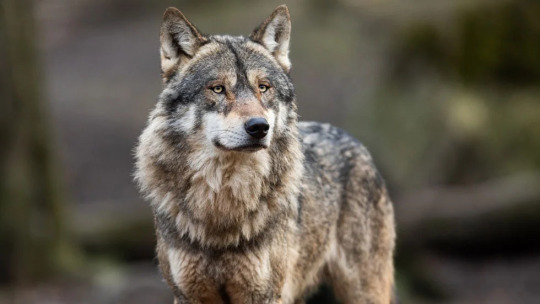
grey wolf, canis lupus the grey wolf has already received an extensive TDF analysis, and overall serve as a general template to which to compare canis lupus subspecies. to point out several unique aspects of the grey wolf, it must be stated that the grey wolf tends to be one of the most social and group-oriented wolves. they have a strong focus on hierarchy and cooperation. they are also highly adaptable and even-tempered, capable of flexible behavior and adjusting strategies wherever they might end up. this makes them rather quietly bold and ambitious people; they are at ease out of their comfort zone, and they are dedicated to seeing their projects and intentions through. grey wolf daemians, in addition to the general wolf traits, are extroverted, confident, flexible, straightforward, and committed.
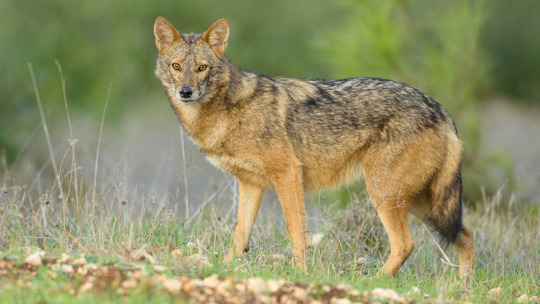
african wolf, canis lupaster the african wolf, also called the golden wolf, is native to northern africa. it is a small wolf subspecies, intermediate between the jackal and the wolf, though its appearance changes based on its location: eastern african wolves tend to be small and more jackal-like, while northern and western african wolves tend to be larger and more wolf-like. despite this, they are genetic descendants of grey wolf and ethiopian wolf cross. african wolves live in small, flexible packs that fluctuate depending on prey availability. their social groups are demonstrative and affectionate; african wolves have frequently been observed grooming, playing, and courting. they are extraordinarily territorial and can be highly aggressive to intruders though interestingly are primarily reactive to intruders of the same sex. altogether, this paints a picture of an individual who's competitive and extroverted, gravitating towards like-minded companions but individualistic enough to head out on their own. their hunting habits are, indeed, varied; african wolves do take large prey, but overall value a generalist diet, employing multiple strategies such as turning over dung piles to find beetles. they will hunt more than they can consume and cache the prey until later — though they are highly territorial and hostile towards other scavengers. african wolf daemians, in addition to the general wolf traits, are adaptable, assertive, individualistic, socially savvy, and inventive.
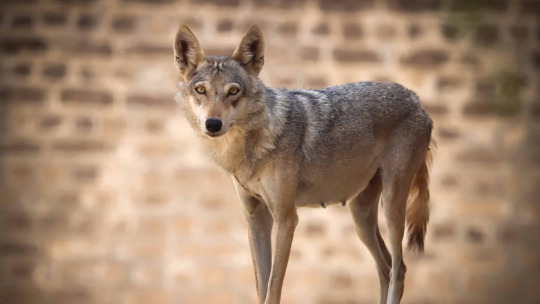
arabian wolf, canis lupus arabs the arabian wolf is native to the arabian peninsula and lives in arid desert and mountain habitats. they are one of the smallest wolf subspecies, also notable for their large ears that help them disperse body heat. these wolves live in small groups and have an opportunistic, omnivorous diet. they tend to hunt alone or in small groups, though there is heavy competition for prey and they will readily rifle through human garbage. compared to grey wolves, arabian wolves are substantially less social. they only aggregate into larger groups during mating season or when prey is plentiful; otherwise, the arabian wolf is less territorial and not terribly communicative, and tends to be nomadic and always on the move. the arabian wolf soul is a perceptive survivalist, highly adaptable but prioritizes their flexibility to such a degree it makes them less likely to depend on others. they're more unobtrusive and self-focused, though they have the capability to be cooperative and are certainly tolerant of others. their competitive nature is essential to their form, however — it's a priority for them to have all of their needs accounted for, but their opportunism makes them highly resilient and they are excellent at completing projects even if it involves cutting corners. arabian wolf daemians, in addition to the general wolf traits, are going to be individualistic, self-motivated, flexible, not picky, and shrewd.
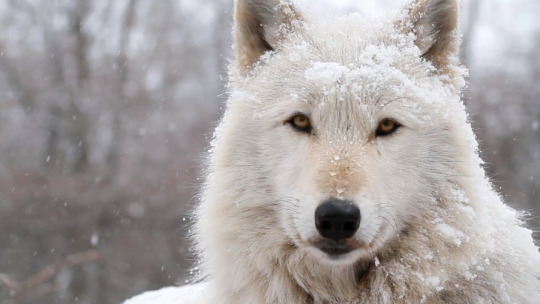
arctic wolf, canis lupus arctos the arctic wolf is a grey wolf subspecies found in the high arctic tundra north of the treeline. these wolves are well-adapted for the snow and cold; they are a medium subspecies with small ears and possess a thick, typically white, double-layered coat. like the grey wolf, they live in packs and pursue large prey such as muskox and caribou. because their habitat is so isolated, they have very few natural predators (besides climate change) and tend to be rather confident and unafraid of people as a result. while arctic wolves are similar in sociability to the grey wolf, they are going to be overall more confident and specialized. these people are highly opportunistic and dogged when pursuing their goals, though they have a preference for depth over breadth. their ambition gives them resiliency and a self-assured nature. due to their tight ecosystem, these people will also be environmentally sensitive and perceptive — it is their preference that things are clear and they are in control, and they will endeavor to maintain stability in their relationships. these wolves also maintain extremely large territories often twice the size of grey wolf territories. an essential quality to this form is going to be how good they are at seeing the big picture, planning ahead, and ensuring their goals will be met. in addition to the general wolf traits, arctic wolf daemians are going to be specialized, confident, perceptive, resilient, and tenacious.

eastern wolf, canis lycaon the eastern wolf is a subspecies found in eastern canada and is sometimes sub-divided into two subspecies: the great lakes wolf (larger, a higher percentage of grey wolf DNA) and the algonquin wolf (smaller, a higher percentage of coyote DNA). since they seem behaviorally similar, i'll be grouping them together. the eastern wolf is descended from a grey wolf/coyote hybrid similar to the red wolf; they are in between grey wolves and coyotes in size, and they live together in tight-knit packs. eastern wolves maintain rather small territories and primarily hunt deer, though their diet also consists of moose, elk, beavers, rodents, and berries. similar to grey wolves, they will often follow ungulate migrations and engage in food caching behavior. overall, the eastern wolf form is going to be fairly similar to the grey wolf. they are highly loyal and inventive, though a key distinction is that the eastern wolf is a degree more unobtrusive and conflict-avoidant than the grey wolf. they likely come across as more introverted and come to life around their loved ones. eastern wolves are also going to be somewhat more attached to routines and a sense of security, flexible when change is needed but not the type to take unnecessary risks. in addition to the general wolf traits, eastern wolf daemians are going to be dedicated, conflict-avoidant, supportive, cautious, and perceptive.
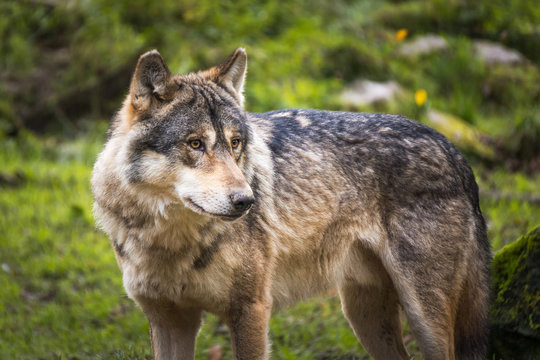
eurasian wolf, canis lupus lupus the eurasian wolf, also called the common wolf, is native to europe and asia and can be distinguished from the grey wolf by their narrower snouts, shorter coats, and melodic howls. though the eurasian wolf has the largest range of all old world subspecies, they have lost a lot of their historical territory. their pack sizes tend to be smaller than grey wolves and they have an extremely varied diet — these wolves are often forced into populated areas and will subsist on livestock and human garbage. they tend to be less skittish around people than grey wolves as a result. similarly, they will often forage independently or in pairs as often as they will hunt in packs. their sociability is similar to grey wolves; eurasian wolf individuals will be similarly extroverted and tight-bonding, though can be distinguished by their survivalist and individualistic tendencies. they have a high degree of adaptability and can be inventive and risk-taking in their problem-solving. while loyal, they have confidence in themselves and their visions, willing to branch out in order to see things through. when compared to the grey wolf individual, the eurasian wolf soul can be distinguished by being more boldly adaptable, socially flexible, and ambitious, highly resilient to hardship. eurasian wolf daemians, in addition to the general wolf traits, are reliable, bold, adaptable, expressive, and quick-thinking.
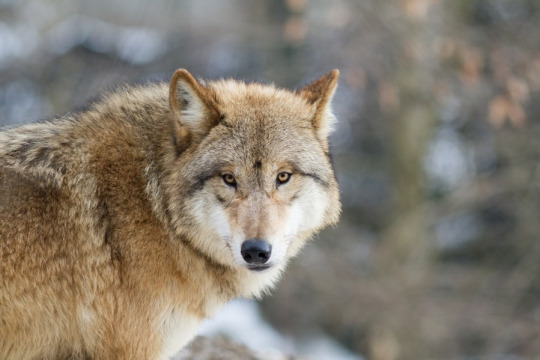
himalayan/tibetan wolf, canis lupus chanco canis lupus chanco, called the himalayan wolf, tibetan wolf, and mongolian wolf, is found in the himalayas, tibetan plateau, and central asian highlands. this species is known for its thick and woolly coat which is typically fawn-colored to help it blend in among the steppes. they live in small packs and hunt both cooperatively and alone; prey include yaks, argali, kiang, antelope, and livestock. other notable aspects of the himalayan wolves is how they are biologically adapted for hypoxia and also have distinctly low and short howls. otherwise, this species closely resembles the grey wolf within its region. slight differences may exist in the himalayan wolf being more resilient and wary in nature, though overall they are still sociable and dependable individuals. likely due to their biome and their sparse distribution in the highlands, himalayan wolves also have a reputation of being less aggressive and territorial than grey wolves as well. these individuals are thus less assertive when their boundaries are crossed and would prefer to adapt their behavior or live and let live to avoid pointless conflict. in addition to the general wolf traits, himalayan wolf daemonians are going to be straightforward, perceptive, confident, tenacious, and tolerant.
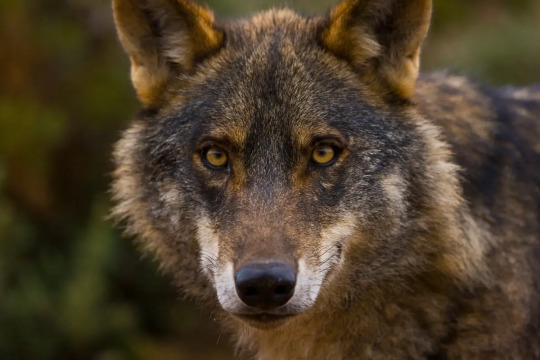
iberian wolf, canis lupus signatus the iberian wolf is native to northwestern spain and portugal in relatively isolated populations that have resisted backcrossing or mixing with other wolf subspecies. these wolves are distinct for their slighter, small frame and the dark marks on their legs, upper lips, and tail (signatus for signed). it lives in small packs and its diet primarily consists of large ungulates such as deer, wild boar, and livestock, though like all wolves the iberian wolf is an opportunistic hunter and will also eat martens, feral cats, rabbits, and rodents. among its packs, the iberian wolf is hierarchical and a cooperative hunter; they have unique howls that are used for individual recognition and the dominant pair in the pack scent marks territory. while the iberian wolf is somewhat adaptable to their biome, they are reliant upon forest cover, and are known to be reclusive and rare even in their region. ultimately, this form embodies many aspects of the grey wolf in terms of expressiveness, group cohesion, and opportunism, but the iberian wolf will overall be more reserved and introverted. they are highly boundary-keeping and assertive — perhaps even wary at first, though natural problem-solvers who have a drive to succeed. their natural confidence makes them rather adamant and willing to take calculated risks similar to the grey wolf. iberian wolf daemians, in addition to the general wolf traits, are going to be introverted, opportunistic, perceptive, expressive, and protective.
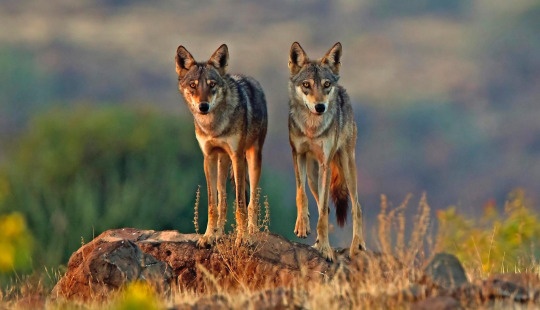
indian wolf, canis lupus pallipes the indian wolf is native to india as well as regions of southwest asia such as turkey and iran. overall indian wolves are small with short, thin fur and they live in open grasslands, thorn forests, and scrublands. while social, their packs are smaller than the grey wolf's, typically an average size of three and are widely dispersed across their habitat. interestingly, the indian wolf is a relatively less vocal species; they seem to rarely howl, though they have a wide repertoire of vocalizations including howling, "social squeaks", whimpers, and whines that they use to communicate with pack members. additionally, indian wolves tend to hunt small prey (such as rodents and rabbits) solitarily and larger prey (such as blackbuck and chinkara antelopes) in pairs, in which one indian wolf acts as a decoy. thus they've garnered a local reputation as extremely reclusive but clever animals — as is required, as the indian wolf has to compete with other local apex predators such as the tiger, dhole, and feral dog. the indian wolf individual is going to display some stark differences compared to the grey wolf, similar to other desert wolf subspecies. the first is that they're going to be much more individualistic, socially selective, and unobtrusive; indian wolves do not defend their territorials as strongly, and overall seem to prefer avoiding potential conflict. they're also going to be quick-thinking and highly cooperative, though even then somewhat reserved, perhaps slow to open up to others and wary about being the center of attention. in addition to the general wolf traits, indian wolf daemians are going to be introverted, observant, cunning, reserved, and conflict-avoidant.
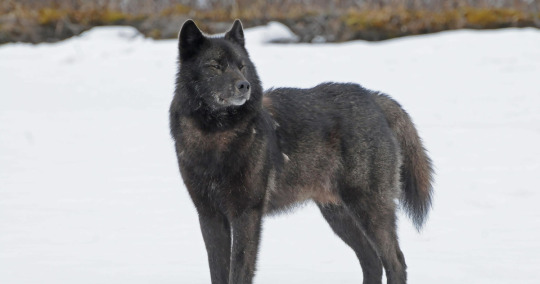
islands wolf, canis lupus ligoni the islands wolf, commonly called the alexander archipelago wolf, is a subspecies found in a limited range in southeastern alaska along the coasts and islands. they are separated from the rest of north america by the coast mountains, creating a unique subpopulation that has resisted inbreeding with other wolf subspecies, coyotes, and dogs. the islands wolf is a small subspecies and is generally dark in color. they live in dense forests where they den in the roots of large trees and primarily hunt sitka deer, though will feed opportunistically on coastal species such as beaver, seals, salmon, birds, and marine invertebrates. their pack sizes can range between a pair or up to twelve members and the islands wolf is unique in that it does not disperse as much as other wolf subspecies and its home ranges are rather small. the islands wolf individual is thus going to show similar social tendencies as the grey wolf while being much more routine-oriented and less adaptable. this is one of the few wolf subspecies that is less opportunistic and highly dependent upon a single prey source; as such, the islands wolf soul tends to prioritize optimization and persistence when possible. they excel at exploiting opportunities though tend to be more sensitive when out of their comfort zone, as their preference is to stay with what is more dependable. it's also likely that they're socially flexible, comfortable in a variety of social situations and particularly cooperative and supportive when times become hard. islands wolf daemians, in addition to the general wolf traits, are dependable, routine-oriented, specialized, precise, and reserved.
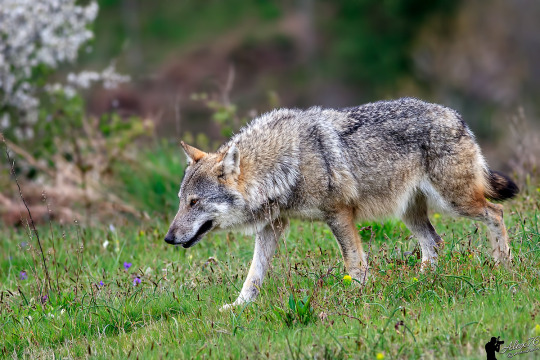
italian wolf, canis lupus italicus the italian wolf is native to the mountain ranges of the italian peninsula, though it has modernly expanded northward into france and the french alps. these wolves are medium-sized and live in packs between two and seven members, though due to prey scarcity, they are most often found in packs consisting of a breeding pair and their adolescent offspring. they are opportunistic predators, feeding on medium-sized hoofed mammals like deer and boar, as well as smaller prey like rabbits, insects, and various fruits/berries. particularly in the summer, they are also voracious hunters of local livestock and will den near the edge of pastures on the mountain ridges. like most wolf subspecies, the italian wolf is also a cooperative hunter and highly social within its pack. similar to the grey wolf, they defend their territories and can be aggressive to intruders. overall, the italian wolf is going to be a similar form to the grey wolf particularly in terms of adaptability. they are confident, perceptive, and flexible, readily adapting or changing course when one avenue isn't working out. their sociability is somewhat more reserved than the grey wolf; they tend to be more private and protective, likely seen as reserved individuals who are tenacious when pursuing their goals or maintaining their boundaries. in addition to the general wolf traits, italian wolf daemonians are going to be dedicated, adaptable, tenacious, confident, and reserved.
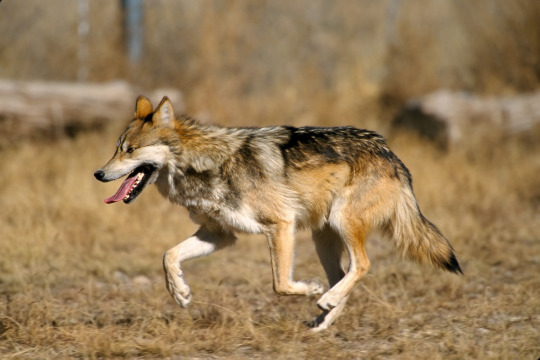
mexican wolf, canis lupus baileyi the mexican wolf is a highly endangered subspecies endemic to northern mexico and the southwestern united states. the smallest north american wolf subspecies, the mexican wolf has long legs and a sleek physique. they live in mountain woodlands and deserts, maintaining large packs similar in size to grey wolves. their diet predominantly consists of elk, though they also will hunt deer, rabbits, and other small mammals, as well as scavenge carcasses and steal prey. these wolves are highly social and expressive; they have strong pack hierarchy and engage in play, vocalizations, and cooperative pup rearing. overall, the mexican wolf individual is going to be gregarious, supportive, and engaging. they are communicative and talkative, expressive and readily speaking their mind. like grey wolves, they're also going to be hierarchical and socially savvy, appreciating the dependability of a group and happy to cooperate to reach their aims. they're also somewhat individualistic like many wolf species, willing to hunt alone and will cache food away from the rest of the pack. despite their environmental sensitivity, mexican wolves are also going to be adaptable and inventive, similar to the grey wolf. mexican wolf daemians, in addition to the general wolf traits, are extroverted, vocal, flexible, energetic, and clever.

northern rocky mountain wolf, canis lupus irremotus the northern rocky mountain wolf is a success story in conserving these subspecies populations. native to the rocky mountains and yellowstone, these wolves became critically endangered as settlers spread west, trapping and killing northern rocky mountain wolves that threatened livestock. massive efforts by the northern rocky mountain wolf recovery plan restored this population to the wild where they now live in idaho, wyoming, and montana. northern rocky mountain wolves are one of the largest grey wolf subspecies, typically bearing light-colored coats and primarily subsisting on large hoofed prey such as elk, bison, and deer. socially, they are similar to grey wolves; this subspecies lives in packs and will hunt communally as well as opportunistically. in terms of form viability, the northern rocky mountain wolf is analytically essentially identical to the grey wolf. one might consider this form if a somewhat more ambitious wolf appeals to them, with an emphasis on smooth cooperation and maximizing output. in addition to the general wolf traits, northern rocky mountain wolf daemonians are going to be cooperative, perceptive, confident, ambitious, and honest.
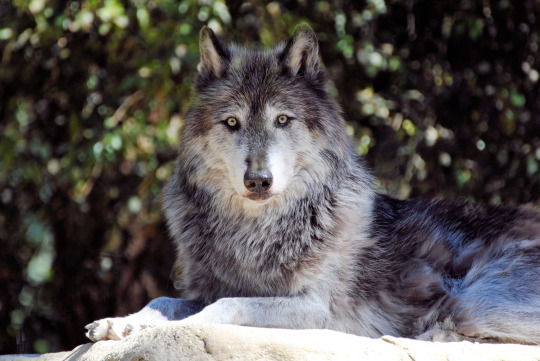
northwestern wolf, canis lupus occidentalis the northwestern wolf is a very large subspecies native to the northwestern united states and southern canada. their bushy fur, size, and short legs help them thrive in the frigid northern mountains and forests. they live in packs of up to over 30 members and primarily hunt large animals such as moose, bison, elk, and caribou, as well as smaller grey like rodents, salmon, and rabbits. they are highly mobile and will travel for 10 hours a day, up to 70 miles to search for prey. their incredible hunting prowess has given them the reputation of being exceptionally intelligent, powerful, and cooperative. compared to the grey wolf form, the northwestern wolf is going to be a degree more reserved, tenacious within their comfort zone and inclined to work in a team. they are enduring and patient when it comes to their ambitions, not the type to shy away from hard work or cut corners if it means getting the best possible result. they're overall still expressive, tight-bonding, and devoted, more sensitive when away from their group. cunning and perceptive, this individual is quietly ambitious and loyal. in addition to the general wolf traits, northwestern wolf daemians are going to be strong-willed, observant, confident, gregarious, and tenacious.
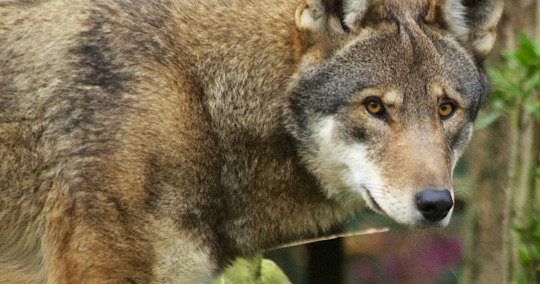
red wolf, canis rufus the red wolf is a subspecies native to the southeastern united states, intermediate in size between the grey wolf and coyote and sometimes claimed to be a coywolf descendant. they are smaller and narrower than grey wolves and possess longer legs and ears. red wolves are historically habitat generalists, and while their range has been reduced significantly, they can still be found in swamps, forests, wetlands, mountains, and bushlands. they live in familial packs, typically consisting of a mated pair and their offspring, that assist in raising pups. overall, the red wolf is more sociable than the coyote but less social than the grey wolf; they hunt in groups or individually, playful with their pack members but highly antagonistic to strangers. they are omnivorous and generalist feeders, primarily eating deer, raccoons, rabbits, rodents, insects, and berries, as well as livestock. despite being highly endangered, red wolves are apex predators within their biome, though they are shy and secretive around humans. compared to the grey wolf, the most obvious distinction is that red wolf individual is going to be more boundary-keeping and private, willing to engage in conflict in order to maintain their peace. they're highly devoted and loyal to their people, but also value their sense of self and their own identity. they're socially savvy and tactful while also quite adamant. like the grey wolf, they're fairly adaptable and tend to be generalists, but tend to be more sensitive. in addition to the general wolf traits, red wolf daemians are going to be sociable, flexible, protective, cautious, and inventive.
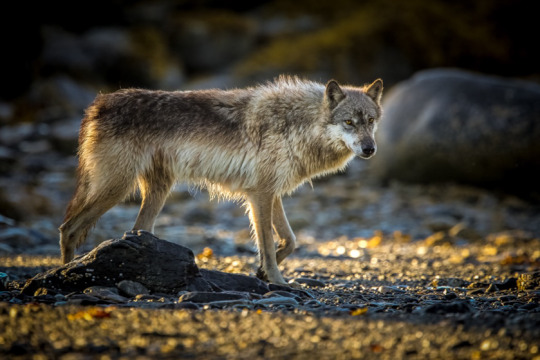
sea wolf, canis lupus crassodon the sea wolf, also called the vancouver coastal sea wolf, is native to the pacific northwest coast of north america. i included this subspecies because of their fascinatingly unique behavior. like many other wolf subspecies, they live in robust packs — however, they primarily feed on fish rather than hunt cooperatively. they will also forage on other marine wildlife such as seals, otters, barnacles, clams, and whale carcasses. often these wolves will forage alone, incredibly adapted for cracking open mollusks with their teeth. they are strong swimmers; they will migrate between islands on the archipelago, swimming between them and following the salmon migrations. sea wolves are notoriously reserved and rarely seen by people, though they're also powerful predators and have been known to fend off black and grizzly bears. their pack life is highly social and wolves spend most of their time together. when comparing interpretation of this form to the grey wolf, sea wolf individuals are going to be highly specialized and reserved, a unique person who seeks out like-minded companions. they are dedicated companions who are adaptable and inventive problem-solvers; these individuals are the sort who always come out on top, good at finding patterns and adjusting their behavior under challenges. they're socially flexible, both cooperative but possessing a dogged individual ambition. in addition to the general wolf traits, sea wolf daemians are going to be problem solvers, specialized, flexible, sensitive, and supportive.
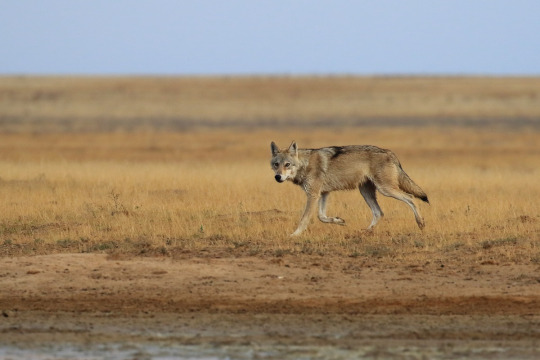
steppe wolf, canis lupus campestris also called the caspian wolf, the steppe wolf is native to the caspian steppes and neighboring steppe regions. they appear similar to the eurasian wolf, though tend to be smaller on average, have shorter coats, and are characterized by their triangular face. these wolves are voracious hunters; they will hunt cooperatively and alone, preying on antelope, livestock, rabbits, rodents, and even caspian seals. while wolves are notable for taking large game and gorging themselves, steppe wolves have been reported to hunt more than they can consume. they also have an aggressive reputation; they live close to human settlements and pick off livestock, and they also appear to have higher than average rates of intra-pack antagonistic encounters. therefore the steppe wolf individual is going to be someone more bold and cutthroat than the average wolf daeman. they are ambitious and much less conflict-avoidant than other species, including the grey wolf, while still being highly hierarchical. this may indicate that they are sensitive to personal disrespect and disruption that affects group harmony. certainly populations of these wolves are brave enough to attack livestock in broad daylight. confidence is a key aspect of this form, perhaps to the point of arrogance in the name of making sure themselves and those they love are taken care of. steppe wolf daemians, in addition to the general wolf traits, are cunning, bold, adaptable, assertive, and achievement-focused.

tundra wolf, canis lupus albus the tundra wolf is sometimes mistaken for the arctic wolf. while arctic wolves live in the northern arctic in regions of canada and greenland, the tundra wolf is native to the tundra of northern eurasia from finland to the kamchatka peninsula. they are of medium size and have thick, fluffy coats that are typically light in color. their diet fluctuates with the seasons; typically they hunt large ungulates such as reindeer, elk, bison, and muskox, though in the summer may also take birds and smaller prey. many aspects of this form is going to be similar to the arctic wolf: tundra wolves are going to be resilient, tenacious, and extremely specialized. this subspecies is heavily reliant upon the reindeer population that makes up most of their diet — their southern range is defined by the reindeer's migration. thus while this subspecies is still going to be cooperative, sociable, and tenacious, they're going to be less adaptable and more inclined to plan ahead in order to avoid obstacles. similarly, as they live almost exclusively in the far north or boreal forests, this subspecies is going to be more reserved and unobtrusive particularly compared to the arctic wolf. they have quiet confidence but may come across as aloof to those who aren't in their group of people. in addition to the general wolf traits, tundra wolf daemonians are going to be introverted, perceptive, specialized, tenacious, and conflict-avoidant.
70 notes
·
View notes
Text

This (from Wiki) is a graph of Earth’s temperature over the last 450,000 years. We are, in fact, in the middle of an ice age, the Quaternary Ice Age, defined by the year-round presence of ice at the poles (for now, *cough*). (For Earth’s history as a whole, permanent polar ice is in fact not the norm.)
The Quaternary Ice Age consists in a series of glacial periods, each about 50 to 100 thousand years long, in which glaciers may come down as far south as Paris and New York, separated by brief interglacials, each less than 20 thousand years, in which the polar ice withdraws behind the Polar Circles. That peak in temperature at the right edge of the graph is our own Holocene interglacial, which began 11,700 years ago. The whole of recorded history, everything from the development of agriculture onward, happened inside it, on the trail of a glacial period ten times longer. We could expect it to end, with the onset of another glacial period, some 10 or 20 thousand years from now, but the effects of anthropogenic climate change on this cycle are not yet predictable.
The last interglacial before ours is known as Eemian (in the European nomenclature) or Sangamon (in the American one). It was a very similar period of warming -- in fact, significantly hotter than our own times, with hippopotami wallowing in the Thames -- lasting from 130,000 to 115,000 years ago. Fifteen thousand years of mild weather, well long enough to fit a story as long and complex as the one from the first Levantine wheat farmers to us (and half again).
In that time, Homo sapiens was still a strictly African species, just making short-lived forays into the Near East; Eurasia belonged to our close cousins, Neandertals and Denisovans, and possibly to the last smatterings of Homo erectus in the southeastern jungles. Our dear brothers Neandertals, whose behavior is revealed ever more complex and imaginative, until their sudden disappearence in the middle of the next glacial period.
What were they up to, in the ice-free Europe of the long Eemian greenhouse, long enough for civilizations to rise and fall a dozen times, long enough to go from the stone sickle to the Mars rover? Most traces on the ground would have been erased when the glaciers came down again, the glaciers whose stupendous weight would carve giant lakes from Erie to Ladoga. What if they had already had better places to go to, when our conspecifics showed up in a land that was already depauperated by frost?
Why would anyone think the “little grey people” in UFOs are aliens? Have you any idea how many specific contingent events made up our evolutionary history, how vanishingly unlikely it would be for the human form to arise on another planet? Those are Neandertals, homesick after thirty thousand years of exile, and they’re coming home.
OK, fine, fine, a technological Neandertal civilization would have left massive evidence (intensive farming, driving out of megafauna, fossil fuel depletion, unusual metal concentrations) that we would have noticed, advancing glaciers would not have erased evidence so completely and in fact would not prevent us from seeing isotopic traces of technical activity, such a civilization would not have been confined to Europe and yet there is no trace whatsoever of pre-Homo sapiens human presence in the Americas or Australia, nor there is any trace of sapient activity in the Solar System older than the 20th century, and UFOs are most probably not real. Don’t take this too seriously, guys.
20 notes
·
View notes
Text
Best Pets for Home: Top 5 Pets and How to Choose the Right One

Finding the best pet for your home involves considering factors like space, time commitment, family dynamics, and personal preferences. Pets can bring joy, companionship, and responsibility to a household. Whether you're looking for a furry friend, a feathered companion, or a low-maintenance pet, there's something for everyone. In this article, we'll explore the top 5 pets for home and offer insights on how to choose the best one for your lifestyle.
1. Dogs
Dogs are often considered the ultimate companions for families and individuals alike. They are loyal, loving, and provide a sense of security. However, owning a dog requires time, effort, and patience.
Popular Breeds for Homes: Golden Retrievers, Labrador Retrievers, Beagles, and Poodles.
Behavior: Dogs are social animals that thrive on interaction and activity. They require regular exercise, mental stimulation, and companionship.
Weight: Varies widely by breed, ranging from 5 lbs (2 kg) for small breeds like Chihuahuas to 100 lbs (45 kg) for larger breeds like Great Danes.
Food: Dogs require a balanced diet of protein, vegetables, and grains. High-quality dry dog food is a good base, but some dogs may benefit from fresh or raw food diets.
Advantages: Loyal, protective, great companions, encourage exercise.
Disadvantages: Require a lot of attention, training, and regular exercise. Some breeds are prone to health issues.
2. Cats
Cats are independent, low-maintenance pets that are perfect for smaller homes or apartments. They can be affectionate without being overly demanding and don't require the same level of attention as dogs.
Popular Breeds for Homes: British Shorthair, Siamese, Persian, and Maine Coon.
Behavior: Cats are curious, playful, and generally independent. While some cats are very affectionate, others may prefer solitude.
Weight: Typically between 8-15 lbs (3.5-7 kg).
Food: High-protein, grain-free dry or wet food is recommended. Cats are obligate carnivores, meaning their diet should primarily consist of meat.
Advantages: Low maintenance, independent, ideal for small spaces.
Disadvantages: Can be aloof, may scratch furniture, litter box cleaning is required.
3. Fish
For those looking for a low-maintenance and visually pleasing pet, fish are an excellent choice. A well-maintained aquarium can add beauty to any room, and fish are quiet, peaceful pets that require minimal interaction.
Popular Species for Homes: Betta Fish, Goldfish, Guppies, and Neon Tetras.
Behavior: Fish are calming to watch and can be mesmerizing with their graceful movements. However, they do not offer the same level of interaction as other pets.
Weight: Varies depending on the species, but most common household fish are small and lightweight.
Food: Specialized fish flakes, pellets, or frozen foods based on the species.
Advantages: Low maintenance, aesthetically pleasing, quiet.
Disadvantages: Require regular water changes and tank maintenance, no physical interaction.
4. Birds
Birds can be wonderful pets, especially for those who enjoy animals with personality and intelligence. Birds range from low-maintenance species like parakeets to more demanding species like parrots.
Popular Species for Homes: Budgies (Parakeets), Cockatiels, Lovebirds, and African Grey Parrots.
Behavior: Birds are social and often form strong bonds with their owners. Some species can even mimic human speech and sounds.
Weight: Varies by species; small birds like budgies weigh around 1 oz (28 g), while larger parrots can weigh up to 3.5 lbs (1.5 kg).
Food: A balanced diet of seeds, fruits, vegetables, and specialized pellets is necessary to keep birds healthy.
Advantages: Intelligent, interactive, can be trained to talk or perform tricks.
Disadvantages: Can be noisy, require social interaction, and may become destructive if bored.
5. Rabbits
Rabbits are great pets for families or individuals who want a soft, furry friend that is relatively low maintenance. They are quiet, social animals that can be litter-trained and kept indoors or outdoors.
Popular Breeds for Homes: Holland Lop, Netherland Dwarf, Lionhead, and Flemish Giant.
Behavior: Rabbits are social animals that enjoy being around people. They can be litter-trained and love to hop around in open spaces.
Weight: Depending on the breed, rabbits can weigh anywhere from 2 lbs (1 kg) to 15 lbs (7 kg).
Food: A diet consisting mainly of hay, fresh vegetables, and rabbit pellets.
Advantages: Quiet, can be litter-trained, good for small spaces.
Disadvantages: Require regular grooming, need space to roam, can chew on furniture.
How to Choose the Best Pet for Your Home
Choosing the best pet depends on several factors:
Time Commitment: Some pets, like dogs, require a significant amount of time for training, exercise, and attention. If you have a busy schedule, consider low-maintenance pets like fish or cats.
Living Space: Consider how much space you have. Larger animals like dogs and rabbits need more space to move around, while fish and small birds can thrive in smaller areas.
Allergies: If you or a family member has allergies, hypoallergenic pets such as certain dog breeds (like poodles) or hairless cats may be a better option.
Family Dynamics: Pets like dogs can be great companions for children, while smaller pets like fish or birds may be more suited to families with older children who understand how to handle animals gently.
Budget: Some pets require more financial investment than others, not only in terms of initial costs but also in terms of ongoing care, food, and veterinary expenses.
Experience: First-time pet owners may find it easier to start with low-maintenance pets like fish or small birds, while more experienced owners may opt for dogs or rabbits.
Final Thoughts
Owning a pet is a rewarding experience that comes with responsibilities. Whether you choose a loyal dog, an independent cat, a peaceful fish, a chatty bird, or a soft rabbit, ensure that you are prepared to meet their physical and emotional needs. Researching the specific requirements of each species and breed will help you make the best decision for your home and lifestyle.
FAQs
What is the best pet for first-time owners? Cats and fish are excellent choices for first-time owners due to their relatively low maintenance needs compared to dogs.
Are rabbits good pets for small apartments? Yes, rabbits can be kept in small apartments as long as they have space to hop around and plenty of enrichment to prevent boredom.
What is the most low-maintenance pet? Fish are considered one of the most low-maintenance pets, as they require little interaction and only need regular tank cleaning and feeding.
Do birds require a lot of attention? Some species of birds, like parrots, require a significant amount of social interaction and attention, while smaller birds like budgies are more independent.
Can dogs be left alone during the day? Some dog breeds can be left alone for a few hours, but most dogs require companionship and exercise throughout the day. Consider hiring a dog walker if you have a busy schedule.
2 notes
·
View notes
Text
Get to know — Draeko Grey
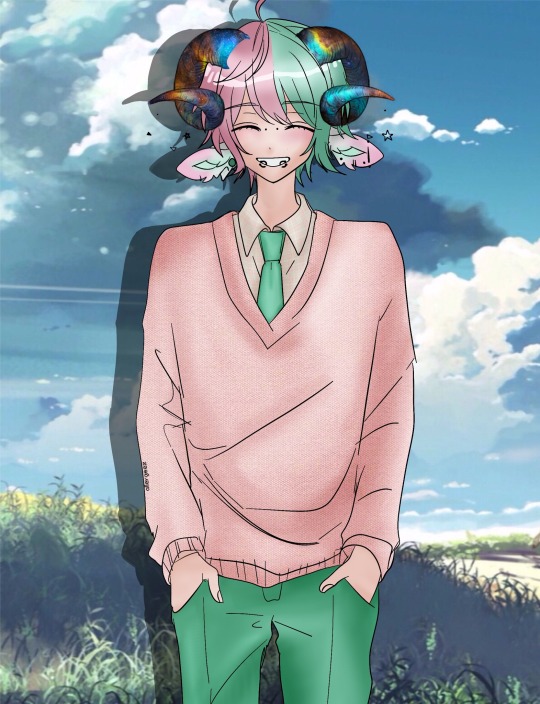
24 // He/Him // Gay 🏳️🌈 // Shifter Mutt (Bighorn Sheep, Chinese Water Deer [Vampire Deer], and African Wild Dog)
Full name: Draeko Aleksander Grey
Nickname: Drae
Date Of Birth: March 5th, 1999
Big Three: Pieces 🌞 Gemini 🌝 Aries ↗️
(under construction!!!!)
Physical Appearance —
Age: 24
Eye Color: Right eye is mint green, Left eye is grey
Hair Color: Split pastel pink and pastel mint green, pink on right side, green on left side
Weight: 108 pounds
Height: 5’4
Race: Shifter Mutt (only mutt ever to have 3 species at once, (Bighorn Sheep, Chinese Water Deer [Vampire Deer], and African Wild Dog))
Distinguishing Marks or Characteristics: Always has deer ears, never human ears. Always drawn with ram horns, which depict a real place in the galaxy, always changing. Is always wearing at least one article of clothing that is pink plaid
Has snake bites, his bridge pierced, his tongue pierced twice, an array of ear piercings, his collarbones and hips pierced, as well as back dimple dermals.
Personality —
Greatest Strength: Seeing the positive in every situation
Greatest Weakness: Taking on his friends struggles, essentially burning himself out
Draeko’s Soft Spot:
Mannerisms: Sweet, sunshine character 🖤🌞
Miscellaneous Trivia —
His ram horns show different spots within space and he can change the location at will, allowing him to accurately read the stars & planets; can give psychic readings based upon that.
Diagnosed Bipolar - 1 ; medicated.
Met Remi & Levi in rehab after getting severely addicted to cocaine and fentanyl, and cruising skeevy sex parties
Sneeze Content —

ALLERGIES
Seasonal allergies that are worse in spring and fall
Grass pollen
Any kind of lily flower
Strong scents or perfumes
How severe are they?
At their worst, Draeko is incapacitated all day, locking himself away in his room alone as to not bother anyone with his constant, rapid kitten-like sneezes, the ticklish cough that gets occasionally brought out by a particularly harsh sneeze, the allergic tears that frequently roll down his cheeks from the intense tickle in his sinuses, and/or his full, congested nose that require him to snort and sniffle to keep the mess from dripping down his face.
Do they get sick often?
No, Draeko usually has a great immune system and doesn’t get sick often.
How bad is it usually?
Since he doesn’t get sick often, when he does, it completely takes the mutt out. He’s melted into a huge blanket on a bed for at LEAST 3 days minimum and very much expects to be carried around via piggyback ride if he for some reason has to leave the bed. Draeko LOVES to be babied by anyone, regardless of their status to him.
Do they stifle?
99.99% of the time, Draeko pinches his nostrils shut while sneezing, resulting in a stifle usually followed by a breathy “Chiiew!”
The only time he doesn’t stifle them is if they come so fast that they even take him off guard, or if he can’t get a hand free in time. Can get pretty messy without stifling.
How loud are their sneezes?
Quiet and kitten-like
What do they sneeze into?
His pinched nostrils, or a pink plaid handkerchief on occasion.
How often do they sneeze?
Often. He’s so used to his allergies and just overall sneeziness that he won’t even stop what he’s saying before a fit, and will keep trying to finish his thought before the fit is over.
How many times do they sneeze in a fit?
Excessively! No less than four times, and extend on for a while.
Do they have build-ups or are they sudden?
Small amount of build up, with the majority being right before the first sneeze in a fit.
Do they sneeze in public?
Yes, Draeko isn’t self conscious about his sneezes at all.
Some examples of their sneezes?
Ihh’gxxnt’iiew!
Hh’NDKT’ih!
H’GXTSH’ue!
K’GNSH’iiew!
Hihh’GXXTsh’iiew!
ehh’Gxxtchh’iew!
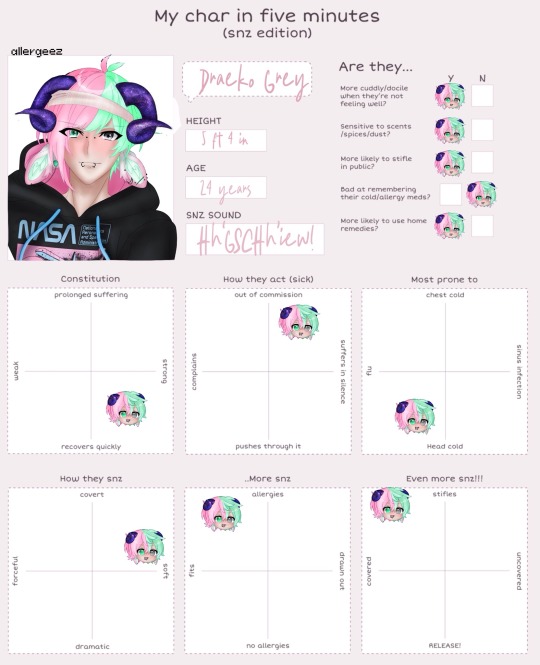
Backstory —
Draeko was born to his Chinese water deer mother, and big horn sheep father as the first of his kind, a mutt of 3 shifter species. 2 species was rare in itself, but 3 species was unheard of. The first few years of his life, he spent happily with both parents who loved each other very much. However, once his shifter natures began to emerge and it was apparent he was different and a species that neither parent had lineage for, his father began to resent him and his mother. His father convinced himself his mother had cheated on him, this being the only explanation he could come up with that his child would have African Wild Dog DNA. One night in the middle of the night, his father had been drinking, and after a while of sitting in front of the blue screen of the tv, loaded the shotgun he owned and shot Draeko’s mother in the head 4 times, before attempting to take Draeko’s life at 5 years old. However, the only shot he managed to put in the mutt child wasn’t fatal, only hitting non vital spots, and he managed to lay still enough to convince the man he was killed. His father then prayed and shot himself in the head, before falling to the floor. The scared child tried to wake his mother, and when that did no good, he could only run. He ran far, far away, as far as his small legs would carry him until he collapsed in the middle of a field. When he awoke again, he was surrounded by strange looking men that all crowded around him, mumbling to each other as they stared. Suddenly, the sea of people split, and a large, stout man with a long red beard emerged, slowly making his way towards the mutt child, before he bent down to a more eye level height, Draeko cowering behind his small hands. The man soothed him, and told him he was almost hit by their wagons, but they managed to avoid him just in time. “Wagons?” The mutt child asked, confused.
“We’re part of a traveling circus, and you’re welcome to stay as long as you’d like if you got no where else to go.” The kind man offered, extending a hand out to the boy, who took it graciously coming to his feet. The man offered him food, his own cot, and the familiar feeling of family he lost so suddenly. Draeko grew up with the circus crew, and it was becoming more and more apparent that the people who bring the most laughs and smiles to others are usually some of the saddest people outside of that. He strived to only see the silver lining on the clouds after this, making it his mission to be the uplifting spirit among the weathered men. But soon the pressure of being the strong one no matter what began to wear on the mutt, and at 14 he became addicted to cocaine, and frequently visited sex parties and clubs until his addictions spiraled out of control, and he found himself also addicted to fentanyl. When he could no longer keep his problems under wraps and away from the men of the circus that he called family, his ‘father’ convinced him to check himself into rehab to find himself and his own happiness again, instead of trying to be that for someone else.
Reference Sheet —

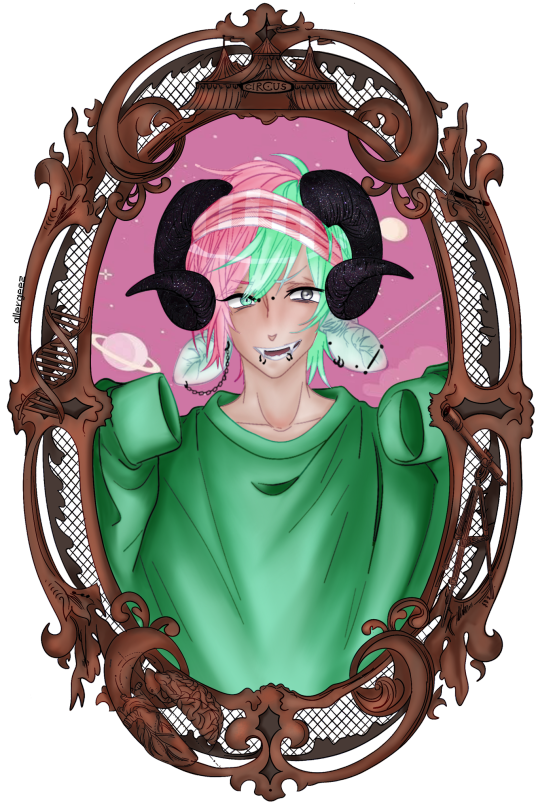

#snz ocs#snzblr#snz kink#snezblr#snz fet#sneeze kink#snzfucker#snz things#snz#snz blog#DraekoGrey#geezieoc#geezieart#kanaixdraeko#alxkoxnai#oc stuff#get to know my oc#oc rp#my ocs#oc art#oc reference#oc bio#oc backstory#oc#under construction#my ocs do not steal#oc masterpost
16 notes
·
View notes
Text
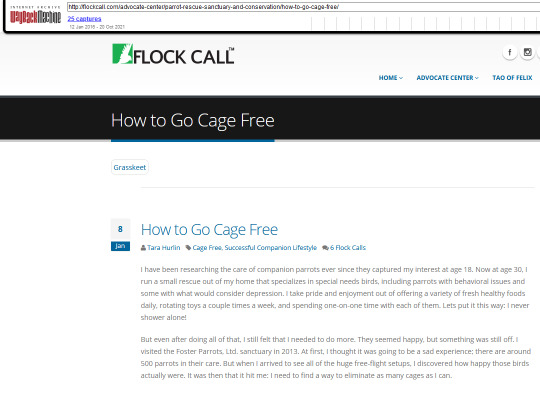
I was browsing my bookmarks, and found a good one that I didn't remember... and that turned out to be gone. I ran it through the Wayback Machine, and turns out the site has been down for a few years.
So, for my own sake and for posterity, I am posting it here, because it is useful information.
How to Go Cage Free
Tara Hurlin
I have been researching the care of companion parrots ever since they captured my interest at age 18. Now at age 30, I run a small rescue out of my home that specializes in special needs birds, including parrots with behavioral issues and some with what would consider depression. I take pride and enjoyment out of offering a variety of fresh healthy foods daily, rotating toys a couple times a week, and spending one-on-one time with each of them. Lets put it this way: I never shower alone!
But even after doing all of that, I still felt that I needed to do more. They seemed happy, but something was still off. I visited the Foster Parrots, Ltd. sanctuary in 2013. At first, I thought it was going to be a sad experience; there are around 500 parrots in their care. But when I arrived to see all of the huge free-flight setups, I discovered how happy those birds actually were. It was then that it hit me: I need to find a way to eliminate as many cages as I can.
Even if they are born in captivity, parrots are wild at heart. They are not domesticated animals; their brains are not wired for life in a cage. Depending on the bird, some think of their cage as a safe place to go to sleep and eat, but others act out, get depressed or start feather picking from boredom. The huge, most important part to consider when thinking about going cage free is (pay attention): You must know your bird, and if you have a flock, you absolutely must know your flock.
It took about a year for my rescue, Hurlin’s Parrot Rescue, to convert to going mostly cage free, and we are still changing things weekly. Keep in mind that we have a flock of 20, and it is a slow process because I allowed everyone to adjust at their own pace. In the beginning, I built jungle gyms hanging from the ceiling out of untreated manila rope. I hung a variety of toys, and they used that as a supervised playtime area – supervised so I could learn who may get along with who, or who was going to be a issue with other birds. As an important note: The large birds such as the Macaws are always kept in separate rooms, the Cockatoos in another separate room, and then the Amazons and African Greys in another.
The next step was to add large hanging perches made out of bird safe woods such as poplar, maple, untreated but de-barked pine, and Manzanita wood. It is important to hang all items with either stainless steel chain or plastic chain, depending on your birds (many will chew plastic chain). I installed dishes directly to the stands and hung toys from the chain so they could reach them. Who got to try out their cage free setup first was based upon each individual’s behavior during the supervised playtime trials. For example, I started with the more shy birds that would need more time to establish their territory, let them get situated, then moved on to the Timneh African Greys who had already established their flock. All the while, I routinely weighed each bird to make sure they were maintaining their weight and not losing due to any stress that may be associated with the big changes. My flock personally had no weight concerns during the transition, but better safe than sorry.
[missing image] When choosing your chain, also make sure that it is safe for little birdie feet. There are certain types known to trap toes.
Meanwhile in the Macaw room, I hung all five of their ceiling play stands in the same day and moved the cages out. Shower curtains were also hung on the walls to assist in their giant poops and food flinging. I did this transition more suddenly because everyone was already used to each other; most had been in the same room for over a year. There is one handicapped Green wing Macaw in this flock, Paco, whose feet were so badly injured that they are paralyzed. Even she is cage-free: I made a play stand that works for her from hula-hoops wrapped in fleece fabric. This works wonderfully, since she is unable to climb or perch, she would just sit in the bottom of a cage all day and crawl through any poop. I had to wash her blankets and bathe her daily. Now she just aims her butt off of the play stand and poops on the papers like everyone else, usually with a little happy dance afterwards!
[missing image] Even handicapped birds have the potential to live cage free, like Paco the Green Wing Macaw.
During the transition, only a few problems occurred: My Scarlet Macaw, Booboo, who is normally a high-anxiety bundle of nerves and plucks herself accordingly, did pluck her feathers during the first week of the change. Aside from being more nervous than usual, she otherwise seemed happier than normal and in bright spirits, and even began to play with toys – something I never saw her do before. She has now fully adjusted and stopped plucking (until another hormone season comes around, most likely).
There are four birds who unfortunately can never be cage-free, but I found this out in the very beginning during supervised play times. One is our male Eclectus, who puts a lot of effort into chasing down the Amazons, and in turn his friend Velvet also cannot be cage free, because she will find a dark corner and get “nesty”, which is something that we avoid here. The Eclectus species also has different dietary needs. Another caged bird is Toby, our “hot” yellow-nape Amazon, but that was common sense and expected, as he is highly hormonal to the point of unpredictable attacks. And the fourth is Buddy the Red Lory for obvious reasons: he’s a completely different species with different dietary needs, and he is a little guy that could easily get hurt.
About three-to-four months after switching to cage free, there is one bird in particular, Spooky the Timneh African Grey, who began to claim to entire room as his territory and bully the other birds, so as a precaution he maintains a cage while we are not home, but the door is opened at all times when we are home. His setup may or may not go back to cage free again in the future. This is a great example of how flock dynamic can change over time, and you as the caretaker have to be prepared to make any changes that come with it. For me, that was regretfully adding one more cage to the bird room, making five cages total – not bad at all if you consider the flock of 20.
I often get the question of “what if a bird gets adopted, or needs to join the flock?” Similar steps will be taken if another bird is relinquished to our rescue and has the possibility of going cage free. Of course, we maintain our quarantine procedures; our quarantine room is an entirely separate room from any of the other bird rooms. Then, once we are positive the new bird is healthy, he or she is brought into the bird room in a cage to gage reactions from the flock and the newbie. From there, the new bird can move to an open-cage status, then possibly cage free. It is important to note that the majority of birds that are easily adoptable into approved homes will not transition to our cage-free flock. This will avoid stress on them if they find a new family, and it will prevent stress on our own flock. With every bird that comes and goes, the flock is affected and the dynamic changes. We take the time to get to know each bird before making any decisions – as much time as it takes. It is our responsibility to do what is in the individual’s best interest, and for our existing flock.
As for maintaining the cage free setup, new toys, swings, boings and other perches are hung and changed out regularly to keep everyone busy. Most of the birds are flighted and will explore the room, but they always return to their “safe spot” on their own play stands for food, water or sleep (with the exception of a few that prefer sleeping up on the ropes).
[missing image] It's important to keep your flock busy by adding random foraging areas and rotating toys.
I wish that I could tell everyone that eliminating cages was all sunshine and rainbows – a piece of cake – but it takes a lot of thought and even more work! It may not be for every flock, and I can’t make that decision for you because only you can truly know your birds. Only you know what your setup is capable of and what is realistic for you.
What I can say is that I have no regrets. I have never seen my birds happier. The sparkle in their eyes shines brighter; they chatter more and interact with each other more, even just vocally from across the room. The vibe in the room is much more lively and happy, and I no longer feel the guilt of seeing so many cages lined up around the walls like little jail cells. A few birds in particular have completely turned around: for example, Ariel, a bird who was locked in a cage for ten years and very difficult to handle due to her mood swings (I self-diagnosed her as being bipolar with possible depression), now constantly asks for me to hold her and accepts preening, almost to the point of cuddling. The first time she did this is a moment I will never forget; it was the kind of moment that reminds a rescuer why they rescue in the first place. Tears of joy filled my eyes. Another change happened in my African Greys, Shelby and Remy. With the cage-free setup they go wherever they please, and that often involves following me wherever I am in the house, which is something I love. They fly back down to their rooms when they decide it is bedtime. Their confidence has become higher from having that independence.
[missing image] Ariel is a more emotionally stable bird after going cage free.
Another perk for me personally, aside from the happy aura radiating throughout my bird rooms, is that this setup is very low maintenance compared to having cages. I spend less time scrubbing cages bars and bottom grates, which means I can enjoy more time interacting with the flock. What used to take a full day to clean now only takes a couple of hours – and that is a full on OCD bird room scrub down. We have leftover rolls of 48” wide paper donated by our local newspaper distributor. The paper is cut into large sections to completely cover the floors in each room. Smaller sections are laid over the main paper for the extra poopy spots for ease of changing it, and it makes the larger portion last longer. I sweep daily, and I wipe the walls and change papers in their entirety a couple times per week.
[missing image] Be prepared to sacrifice your wood trim... And doors!
I still continue to make changes to the bird rooms, and this will be an ongoing thing. Another large phase that will take place in spring/early summer 2016 is switching out all of the wood trim for tile or stainless – whichever I find the most cost effective (or the least ugly). Lucky for the flock, I didn’t care for the wood trim we had in those rooms, anyway!
[missing image] A glimpse of the mostly cage-free setup. Buddy the Red Lory's cage is to the left, and to the right (not pictured) are the other two cages for Velvet and Shifu, and Toby.
[missing image] Another shot of the same bird room showing the other two cages. An air filter and backup heat (vented to the outside) is also in the photo.
Main Points for going cage free:
Know your birds.
Be patient and observant.
Weigh your birds regularly to make sure they are maintaining weight and health.
Be prepared to make changes as flock dynamics change.
Adjust with the flock; you are part of it.
You better not care about your trim or possible furniture in the room, or have plans to change to un-munchable trim, like tile.
Keep them busy by changing out perches, toys and foraging activities. It’s like having a caged setup, but on a larger scale with no bars, so you have to get creative.
Enjoy watching your flock be a flock, and take pride in being part of it.
4 notes
·
View notes
Text

Is that ROME FLYNN? No, that’s DELCAN MILES. The 30 year old ANCESTRAL WITCH - ALPHA CIS MALE is a/an/the RIDER AGENT. If you ask their friends, they’re known to be CHARISMATIC & CONFIDENT, but beware, they’re also known to be VAIN & FLIGHTY. Can you believe they’re from THE PRESENT? Me either.
Name: Declan Miles Nickname(s): none(yet) Age: 30 Date of Birth: TBD Place of Birth: New Haven. Gender: Male Secondary Gender: Alpha Occupation: Agent Rider Family: Anthony (sire), Julius (mare, deceased), one older brother, one younger (Dominic).
APPEARANCE:
Height: 6'2" Weight: 225 lbs. Body: Muscular Hair Color: Black Eye Color: Dark Grey Tattoos: Has a few protection sigils on his arms and legs, though up until recent events, Declan wasn't sure if they would be useful while in New Haven. Piercings: Varied, has a customizable stud earring with a piece of iolite, or any other indigo gemstone, fitted into it. Distinguishing Features: round ass, great body from working out and working as a rider, a charming smile he's most likely used to get into an omega's bed.
SPECIES:
Species: Hereditary Witch Linage: 2 Centuries Familiar: Giant African Snail Known Spells: Yes, he knows spells (Will add later)
PERSONALITY:
Positive: Charming, Brave, Clever, Confident Negative: Ignorant, Stubborn, Abrasive, Hot Head Pet Peeves: People (Omegas) That Can't Take A Joke Hobbies & Interests: TBD, Omegas
NSFW:
Kinks: Rough Play, Knotting, Breeding, "Wham bam, thank you man.", Semi/Public Sex, Anti-Kink: Gore, Scat, basically any bodily fluid that is not slick or cum, Watersports. Safeword: Red=Stop, Yellow=wait, Green=go. Dick Size: 11 Inches
BIO: (still under construction)
The golden child of the Miles bloodline, an alpha witch with two centuries of magic behind him and promising future ahead of him. At least that's what his father has taught should be his life. Declan wasn't going to lie, he enjoys all the benefits of being an alpha in New Haven. He likes to think being born in New Haven was a gift to the town itself. His father, a powerful witch and epitome of everything Declan wanted to be, taught him what the true meaning of being an alpha. And since then knew that his birthright was to knot and plug up lesser omegas.
4 notes
·
View notes
Photo

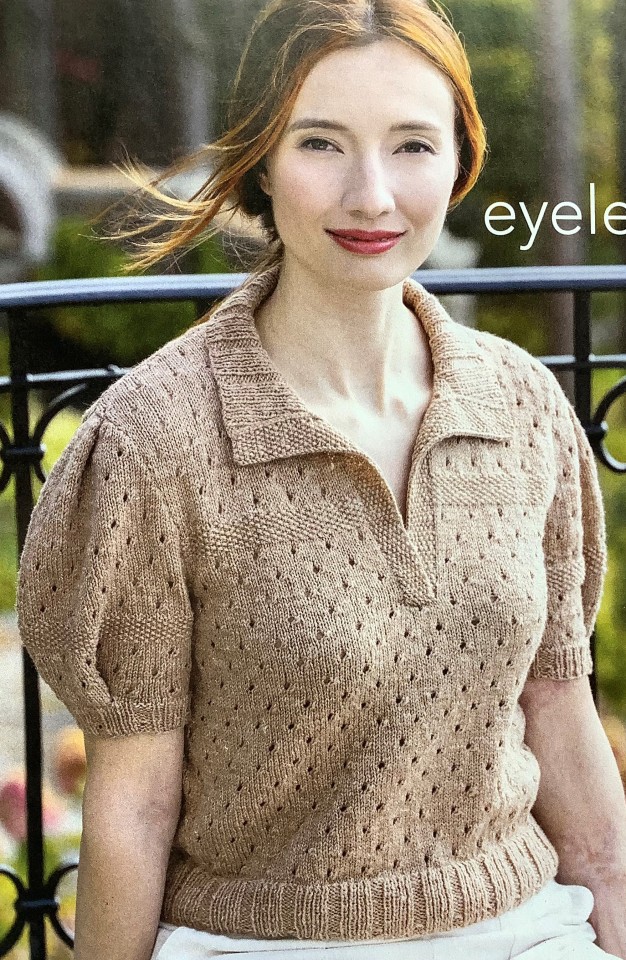

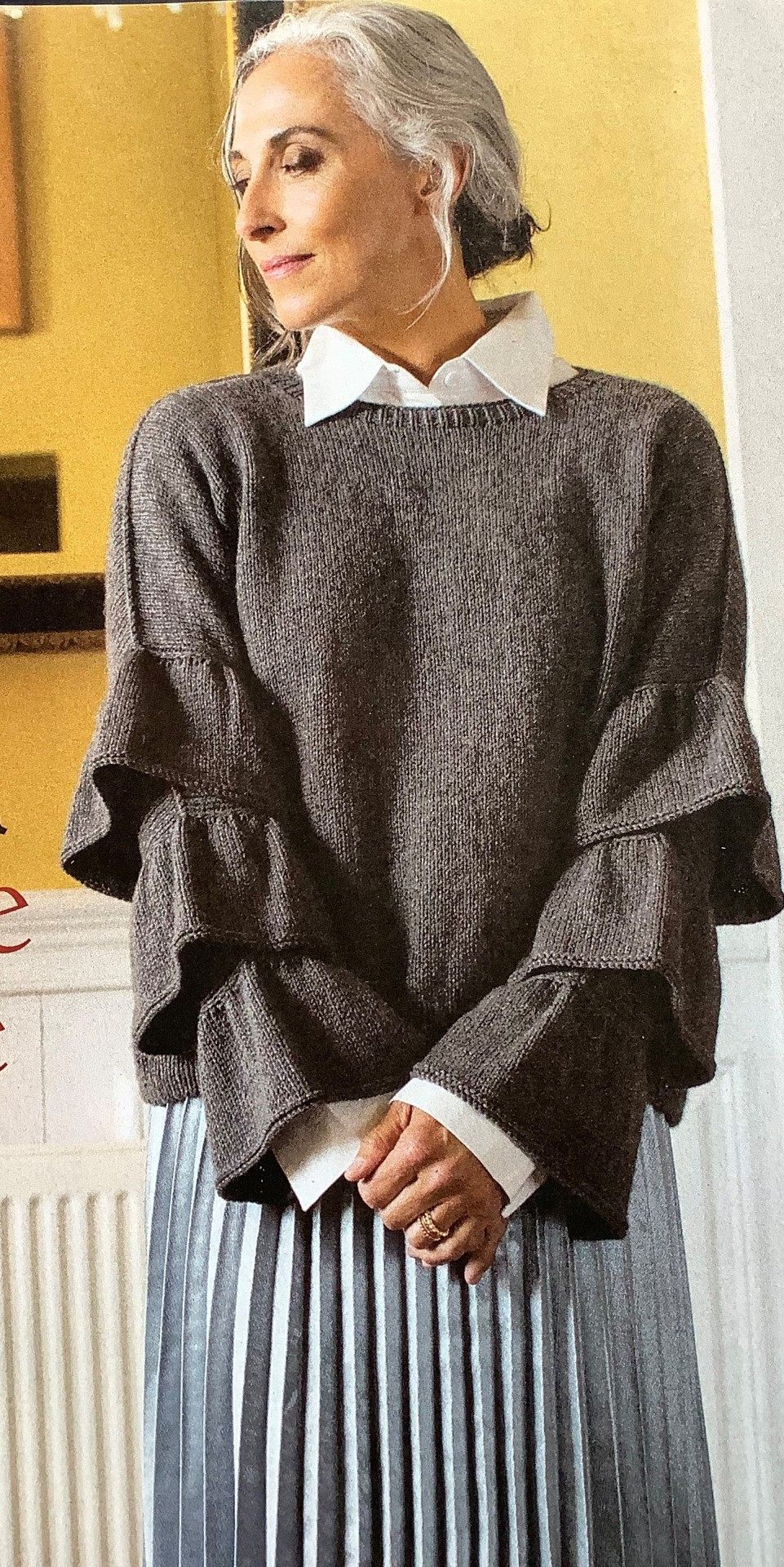

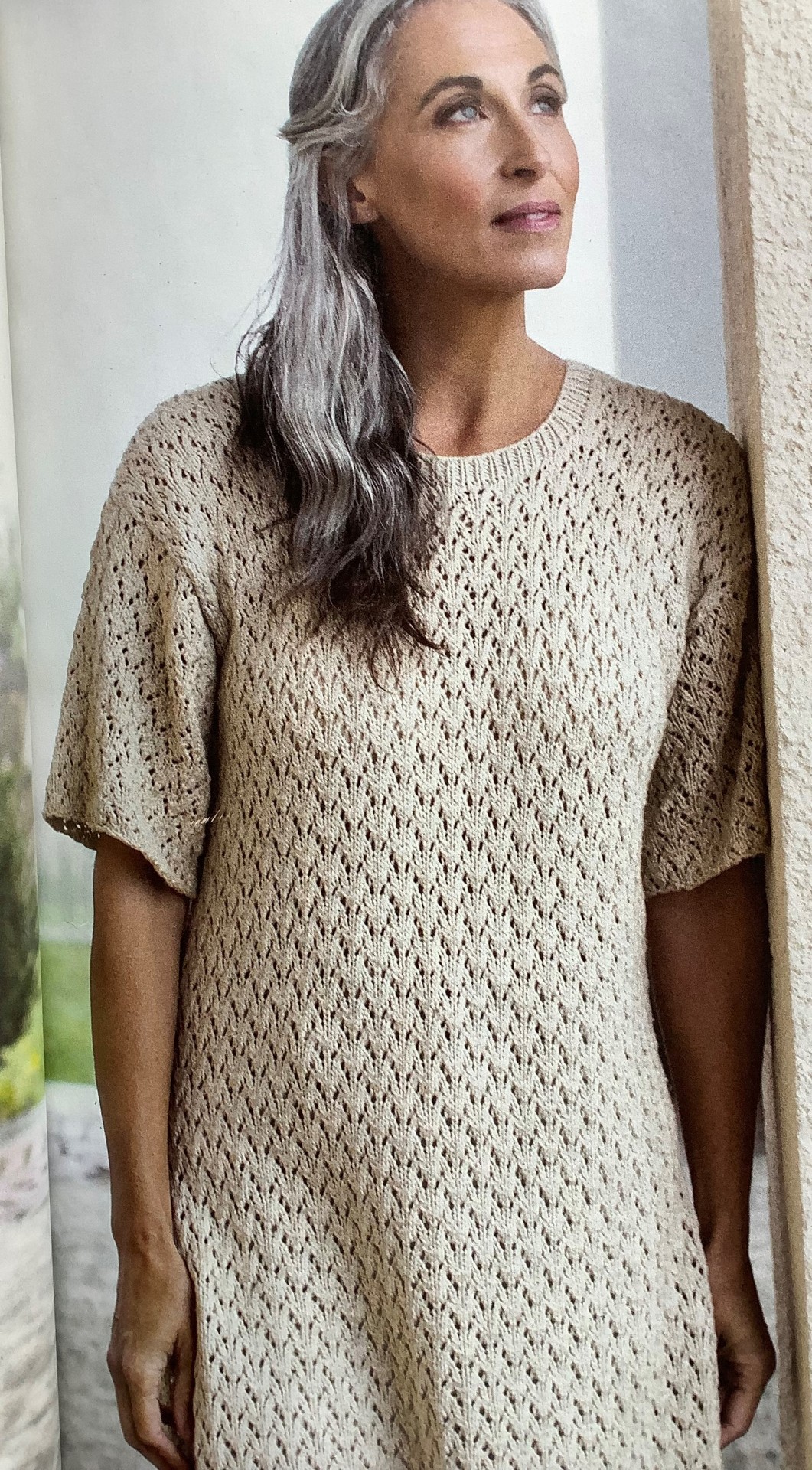
Vogue Knitting, Spring/Summer 2023
This issue has you ready for warmer days with no-sleeve and short sleeve looks. The most playful is the Popsicle by Mari Lynn Patrick who calls it a quick knit although it is a 3 out of 4 for difficulty. It has asymmetrical shoulders and ribbing through the body. It is done up in Anzula Vera which is a sport-weight yarn made of silk and linen, and that lovely rosy color is called Blush.
My favorite because of its vintage look is the eyelet patterns Campanula by Deborah Newton, a fitted polo collared pullover done in a taupe. 3 out of 4 for difficulty, it is done up in Skacel ALB Lino, also a sport-weight yarn and made of a blend of wool and linen.
A section of paired sweaters--one simple one dolled-up--gives us the strapped v-neck called The Artist by Melissa Leapman that is a 2 out of 4 for difficulty. It uses Blue Sky Fibers Skinny, a worsted weight cotton yarn and appears opposite a plain v-neck also by Leapman. Similarly, the ruffled sleeves on a charcoal grey, crewneck pullover accompany a plain crewneck. The ruffled version is called The Muse, and is 2 out of 4 for difficulty. It is made in Berroco Luca yarn, a worsted weight cashmere and cotton blend, and both are by Norah Gaughan.
Vista is the cream-colored tunic is by Lavinia Voiculescu in Cascade Hampton which is a DK-weight yarn in a blend of cotton and linen. Although the eyelet pattern makes it look complicated, the shape is very simple and the difficulty is only 2 out of 4.
Lastly, on the cover is The Dancer by Donna Estin which is made up of a boucle yarn, hence all the appealing texture, The yarn is called Curiosity by African Expressions which is blended wool, polyamide and mohair which is also a DK weight yarn and the pretty blue color is #9112. The sweater is a 2 out of 4 for difficulty.
In addition to interviews, and columns on new books, new yarns, new products, Meg Swansen shares some knitting tips from her mother Elizabeth Zimmerman.
You can find it at your local yarn store or online here: https://www.vogueknitting.com/
#vogueknitting#vogueknittingmagazine#knittingmagazine#springknittingpatterns#springfashions#elizabethzimmerman#megswansen#africanexpressions#donnaestin#thedancer#cascadeyarns#vista#laviniavoiculescu#norahgaughan#themuse#berrocoyarns#blueskyfibers#melissaleapman#theartist#skacelyarns#deborahnewton#campanulapullover#popsicleshell#marilynnpatrick#knitting#knittingpatterns
8 notes
·
View notes
Text
House of Asmodeus
Nameless ghouls and ghoulettes x ocs (Aether included)
The summoned info
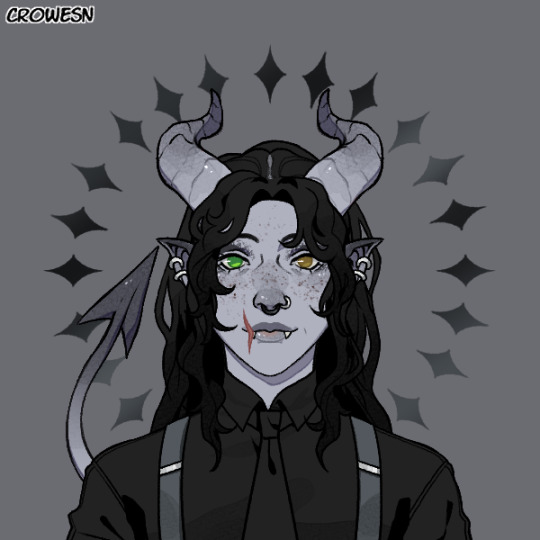
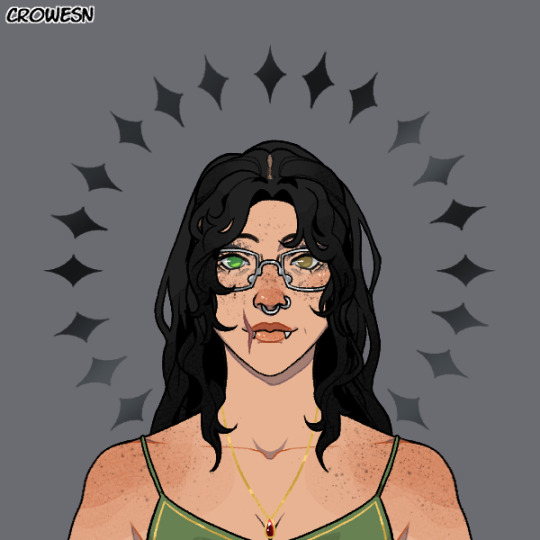
Name: Amber
Nicknames: Amb/s, Ammie, Berry
Age: 2029(28)yo,
Height: 5'10
Weight: 145lbs
Hair: Long black with white and grey streaks
Eyes: one Hazel eye - one amber eye
Disc: Splattered grey and light grey skin ghoul colored skin, She wears Kandi from other Ghoulettes, she wears 3 silver rings, she is the Clergy Florist, when she's at the ministry and rituals she wears the ghoul uniform, but when outside of those, she wears flowy earth toned fabrics.
Pronouns: She/Her
Instruments: Bass, Piano, Vocals, Tambourine
Ghoul Type: Multi Ghoul (Aether, Aura, Fortune) -----> Mate: Swiss, Aurora
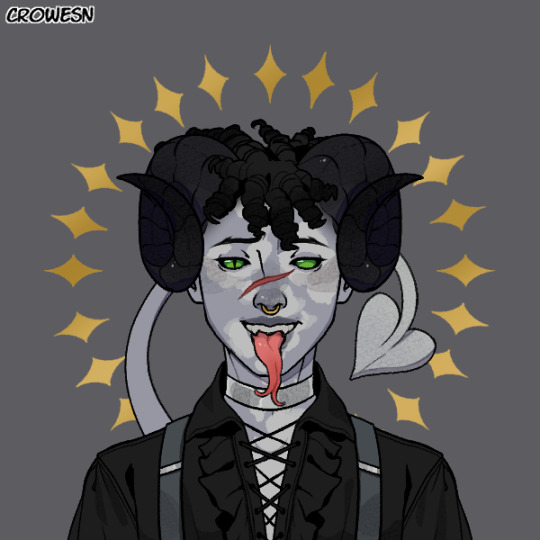
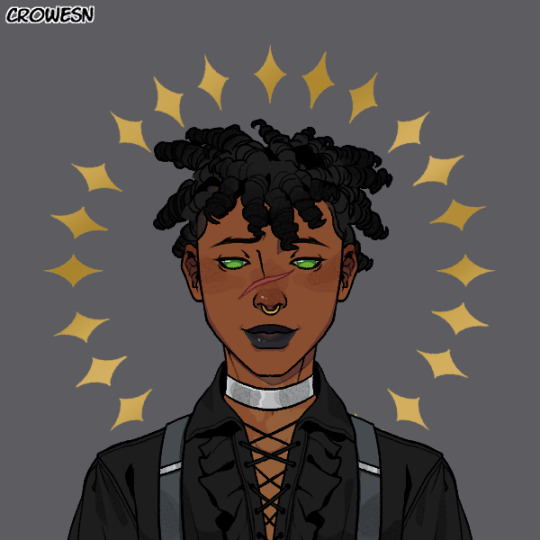
Name: Asmodeus
Nickname: Asmo, Deus, Ozzie, Momo
Age:1,829 (23)yo
Height: Ghoul form 5'11, Glamoured: 4'11
Weight: 115lbs,
Hair: short curly mohawk
Ethnicity: African American / Caribbean
Eyes: has green eyes that creep people out but when glamoured they are dookie brown
Description: ghoul skin is darkish gray with lighter gray splatters, has a septum, womb tatt, wears a gold bracelet on the left wrist, wears the ghoul uniform but when not in uniform stays true to their nature (a whore), Ram-like horns that are decorated with gold chains, gold ankle cuff from mountain, gold arm cuffs from phantom, spaded tail with a red heart on the spade (Glamoured: Brown skin that has patches of lighter skin sometimes chooses to leave eyes green.) When scared or anxious they poof into a bat(has to do with being part quintessence), has ADHD, has phonic tics (echolalia), frog blinks, has an attention span the size of a pea unless it's mountain or phantom talking. Has sensitive hearing and doesn't like touching food often eats with gloves or is fed by Mountain. When not a total whore you can find Ozzie being a big baby whether it be with Phantom or Mountain. Got in a fight with another ghoul that's the reason there is a scar across their nose. When not on the road with the band Ozzie plays music at a lounge inside the ministry that he opened (lots of stuff happens there that shall not be mentioned), When summoned they stayed glued to Eros not talking and constantly covering their ears until they got used to being on the topside. Eros and Rain introduced Ozzie to Mountain hoping that being around an Earth Ghoul would help getting used to things. He is scared of a blender.
Ghoul Type: Multi Ghoul (Earth Ghoul & Lust)
Instruments: Trumpet, piano, bass, drums, and cello ( is secretly good at singing but has a somewhat a low ass voice)

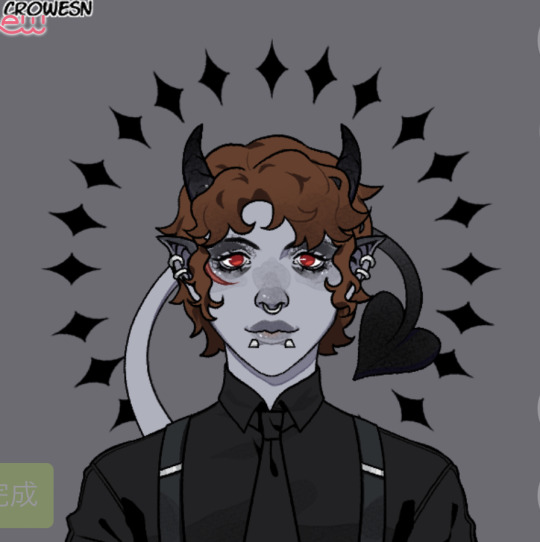
Eros (Ghoulie):
Age: 892(20)yo
Height : Ghoul: 5’4 Glamoured: 5’0
Weight 175 lbs
Ethnicity: Native American (Navajo tribe)
Hair: Short dark brown wavy, swept to either side (kinda like Cosmos but shorter) dyed streaks (color varies) Eyes: Unglamoured: fluctuates range from dark red, purple, pink, and white or will be a mix like a rainbow of those colors. Glamoured: Dark brown, looks black
Ghoul Type: Multi Ghoul (Fire, Quintessential, Lust, Air) → Mate: Rain
Pronouns: He/Him
Gender: Trans Male (FTM) but fluctuates from feminine clothing appearance to masculine
Instruments: Guitar, Vocals (Tenor to high soprano range), Keyboards
Description: Ghoul skin is Darker gray with black ombre effect on ends of fingers/hands, ears (medium pointed), and tail, Glamoured: skin is dark tan. Horns are medium size, black, curl in spiral like a ram’s horns with a silver ring that has small blue diamond (from Rain awe) on left side but will occasionally wear it on his left ring finger in his glamoured form and sometimes in his unglamoured form, tail is long and thin, spade is a heart shape with three small silver hoop piercings on one side all in a row, has womb tatt, Piercings: snake bites, nostrils, septum, eyebrow (right side), ears, three column on one side of spade tip, wears as much kandi as he can (gifts from rituals), black hoop earrings with a pentacle and inverted cross, nostril piercings are connected with silver chain that goes over top of nose, septum is just simple silver hoop as well as snake bites and eyebrow, nails are short black, two middle fingers have capricorn and pisces constellation on black color, scar on lower outside of right eye from his previous abusive mate he killed, wears ghoul uniform without cape, prefers to wear prequelle ghoul mask outside of rituals cuz it makes him feel more masculine but will wear impera mask if he has to, outside of rituals he dresses like a whore on fem days, really short mini skirts, thigh highs, garter belts, chains, all that type of stuff, masc days, baggy cargo pants, chains, baggy band tees, arm warmers, doc martins or converse same goes for fem days, wears eyeliner no matter what every day, autistic, anxiety, depression, cptsd, ADHD, echolalia (also comes from the autism), sensitive hearing, hates certain textures,hase a specific way he has to do things and a specific routine that he has to follow oe else he will freak out (autistic as hell),will go non verbal when overstimulated or will full on start crying if it’s bad enough, Rain usually knows what to do and will help him calm down in like 5 minutes (really helpful if the meltdown is less than 10 min before the ritual starts), he also age regresses, hella kinky its criminal, concerning attachment issues to the PapaIV plushia literally carries him around and takes care of him like his own child, Rain is a little uneasy around the plushia cuz its so ugly but he loves Eros so he doesn’t mind it and helps “take care” of him when Eros leaves him with Rain, was terribly frightened and did not speak at all when he was summoned (kind of a problem since he does backing vocals), hard time adjusting to new places and new routines but Rain helped him get more comfortable and brought him out of his shell, he would hide from the other ghouls and Copia in his room under the bed and would rarely come out for activities and meal times when first summoned, acts like a brat and a whore now that he's used to the others
#ureternalmajesty#nameless ghouls#namelessghoulettes#ghouls#ghoulettes#the band ghost#ghost bc#crackic#me and the besties writing#ghostbc#papa emeritus iv#evil seestor
5 notes
·
View notes
Text
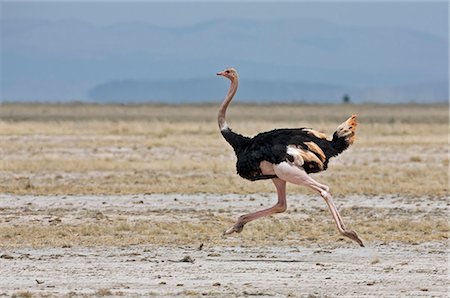
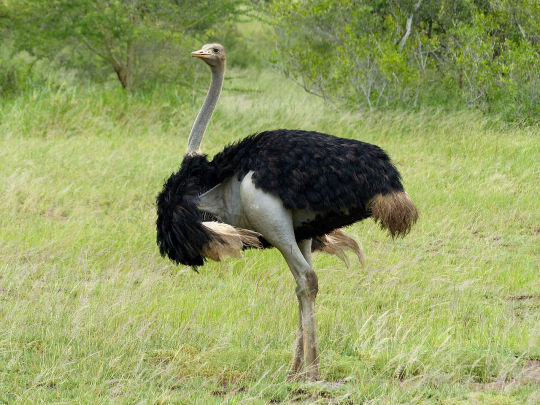
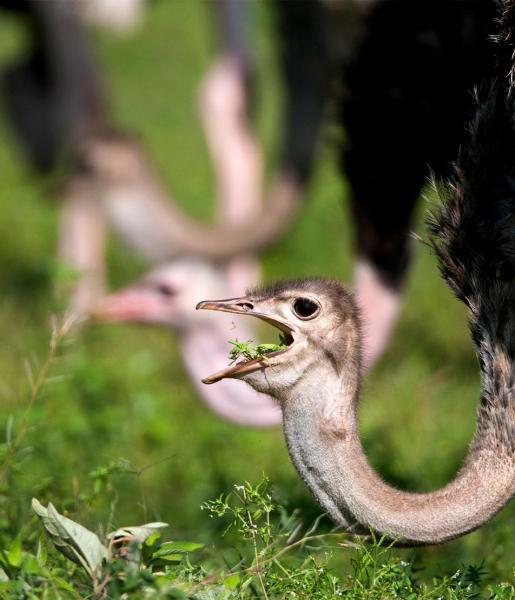
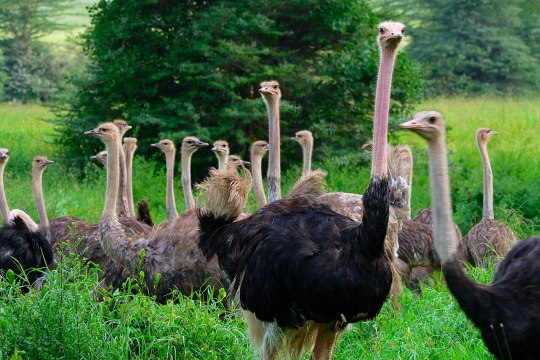
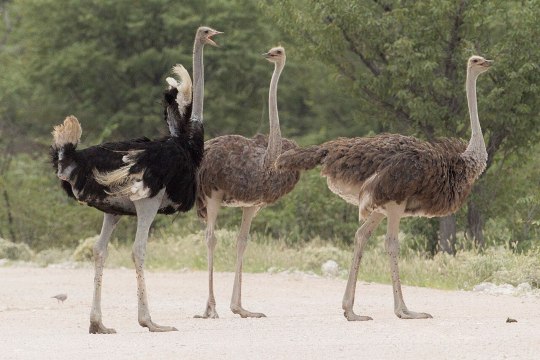
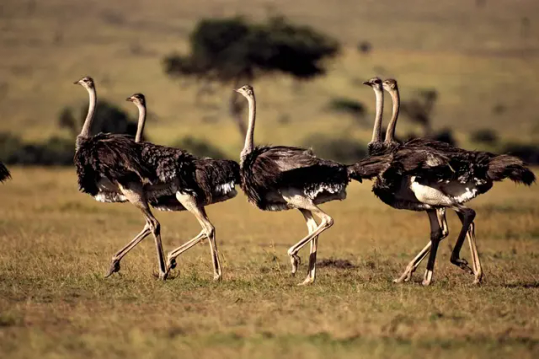
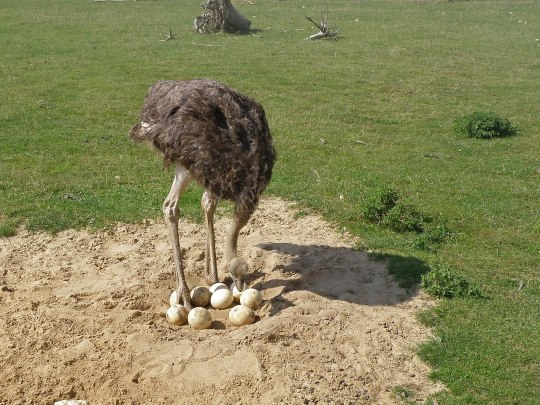
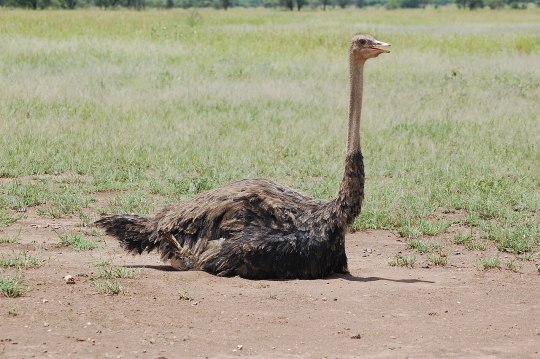
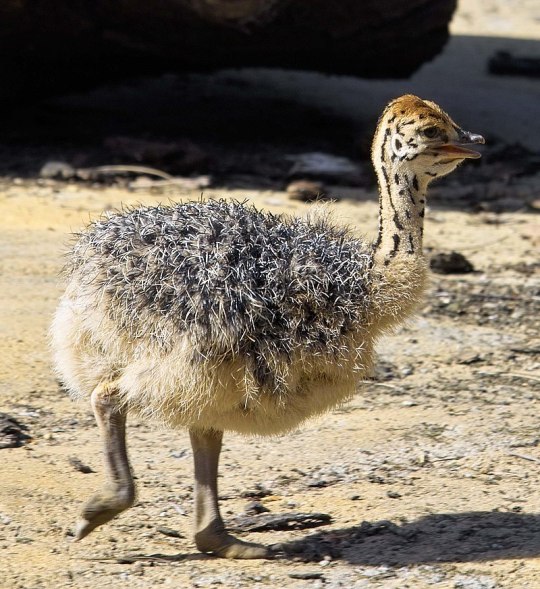
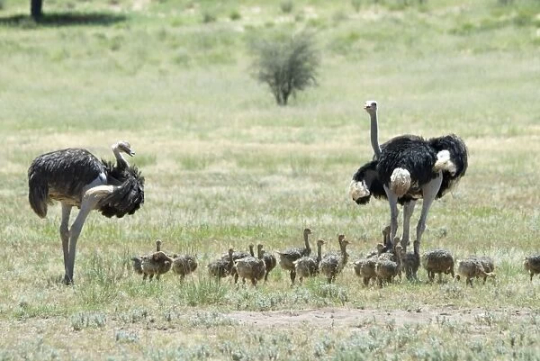
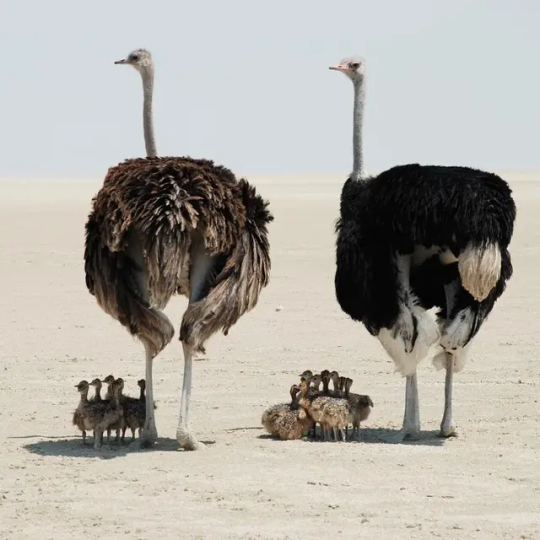
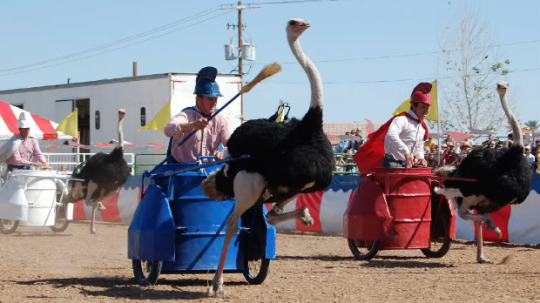
Struthio camelus, also known as the common ostrich, is a species of flightless ratite which was once native to India, the Mediterranean, and the middle east, but can now be found throughout much of Africa, with introduced populations occurring in Australia. They inhabit grasslands, scrublands, dry forests, and deserts where they feed upon various seeds, nuts, fruit, flowers, shrubs, and grasses as well as insects, small reptiles, and carrion. Common Ostriches are themselves eaten by cheetahs, lions, leopards, African hunting dogs, and hyenas. Common ostriches have many antipredator adaptations, such as great eyesight, and long muscular legs which allow them to deliver powerful kicks and run at up to 50mph (80km/h), making them the fastest animal on two legs. They also live in nomadic fission fusion flocks of up to 100 birds, which often travel alongside herbivores like wildebeest, zebra, and antelope. With females reaching around 5.9 to 6.3ft (1.75 to 1.9m) tall and 130 to 260lbs (59 to 120kgs) in weight and males reaching 7 to 9ft (2.1 to 2.75m) tall and 180 to 345lbs (82 to 156kgs) in weight, the common ostrich is the largest of all extant avians. Males have black body feathers and white feathers on their wing-tips and tails, while females have grey-brown body feathers. There necks are long, eyes and large, and feet are broad only sporting 2 toes. The mating season lasts from March to September. During such time males establish a territory, then females break into groups of 2 to 7 lead by a top hen who evaluate and select a specific male to mate with the entire breeding season. After the initial mating the male will dig a nest; a shallow dip in the ground in which the top hen will lay 7-10 eggs. Subsequently, the male will mate with all females in the group. These females will each lay their eggs around the top hen's, once around 20 to 60 eggs have been laid the top hen will incubate them during the day, while the male will incubate them at night. After 35 to 45 days, the eggs will hatch and the male will take care of the chicks until they are about 10 months old and capable to fend for themselves. Under ideal conditions a common ostrich will reach sexual maturity at 2.5 to 4.5 years old and may live up to 70.
#pleistocene pride#pliestocene pride#common ostrich#ostrich#ratite#bird#ostrich riding#ostrich racing#chariot racing#wildlife#animal facts#birds
6 notes
·
View notes